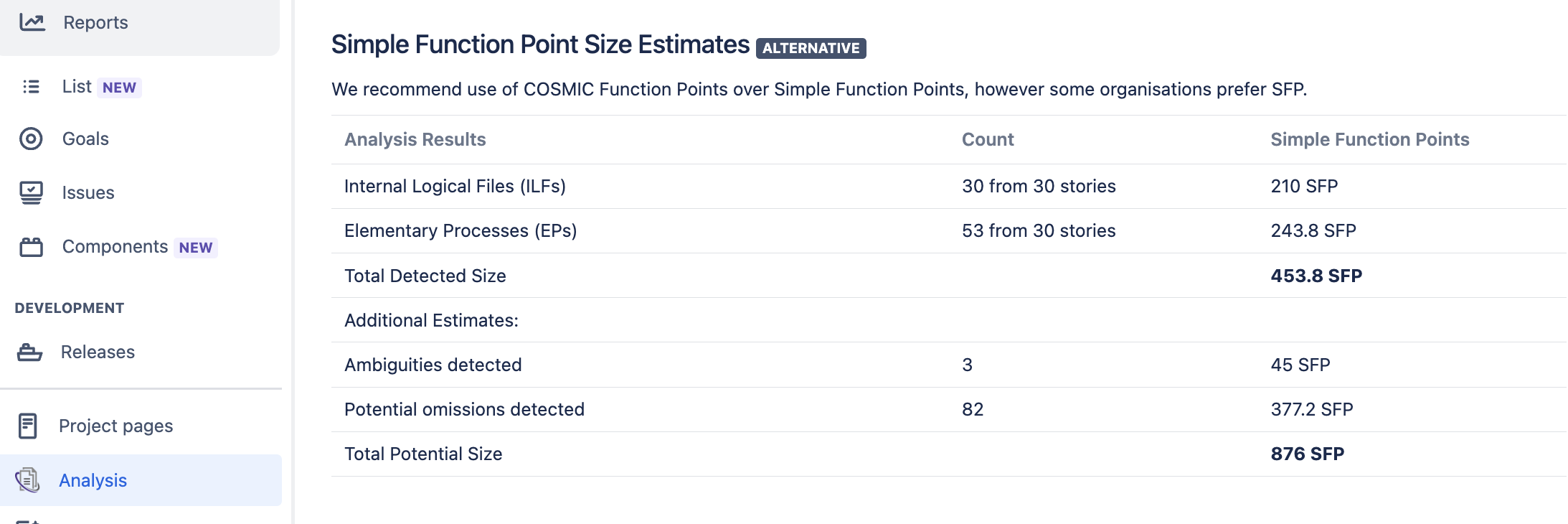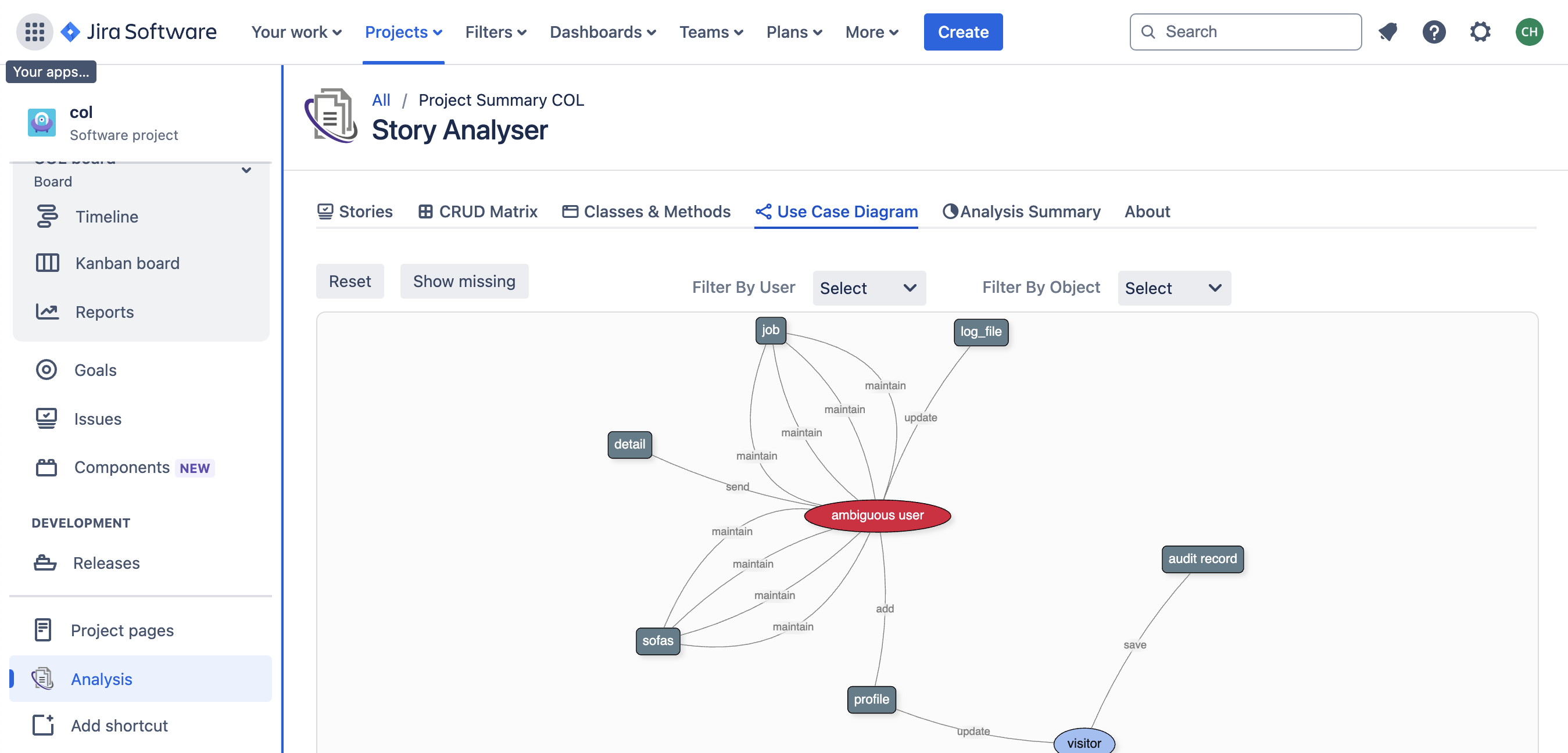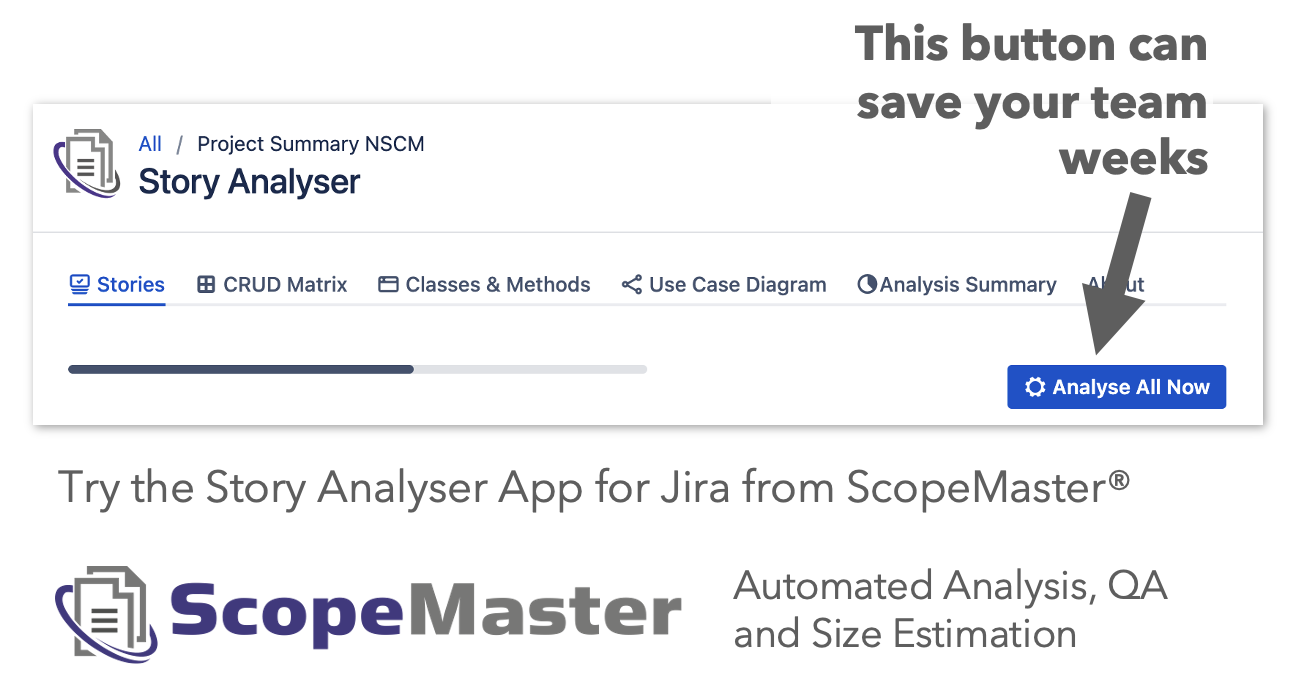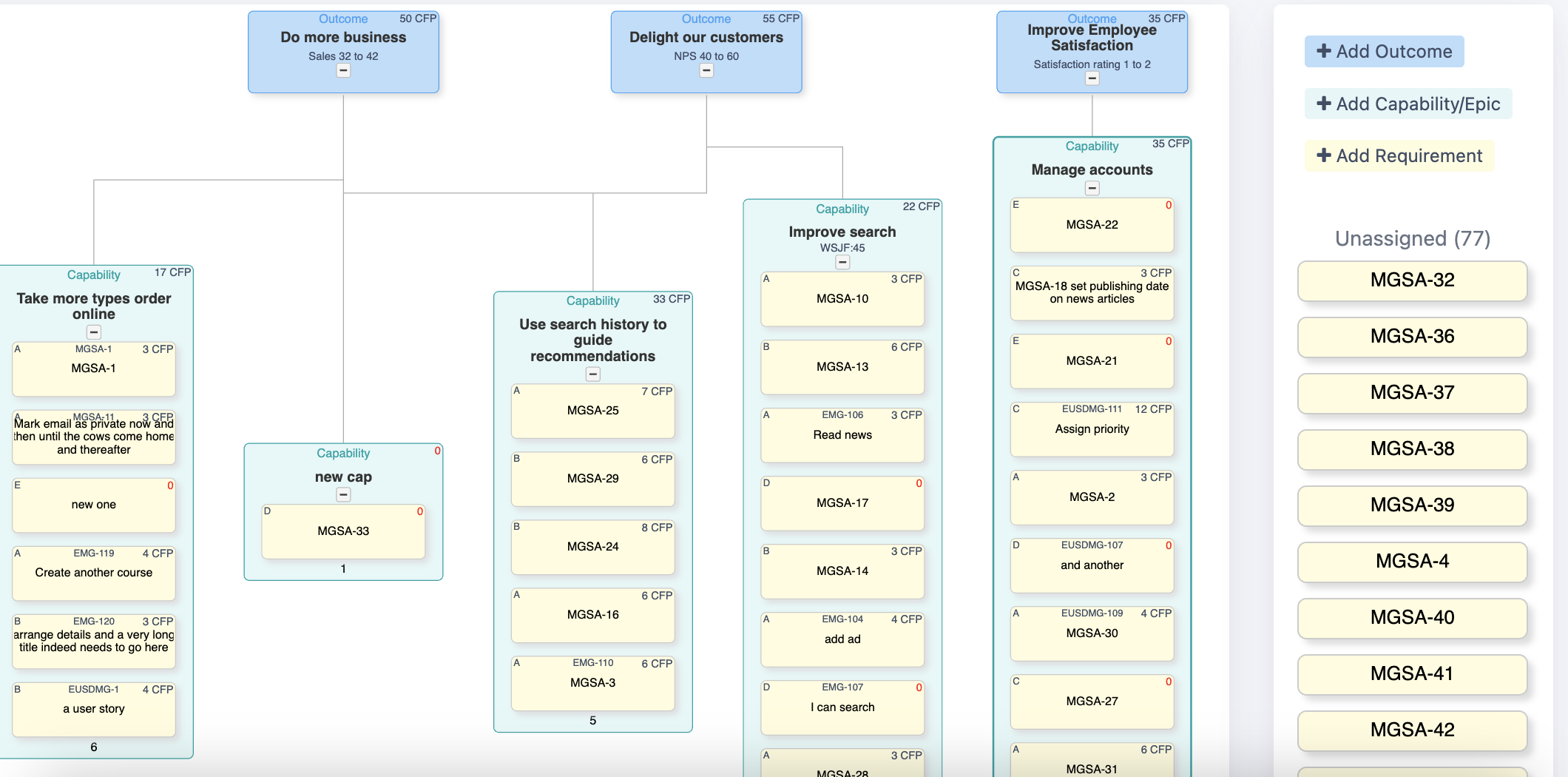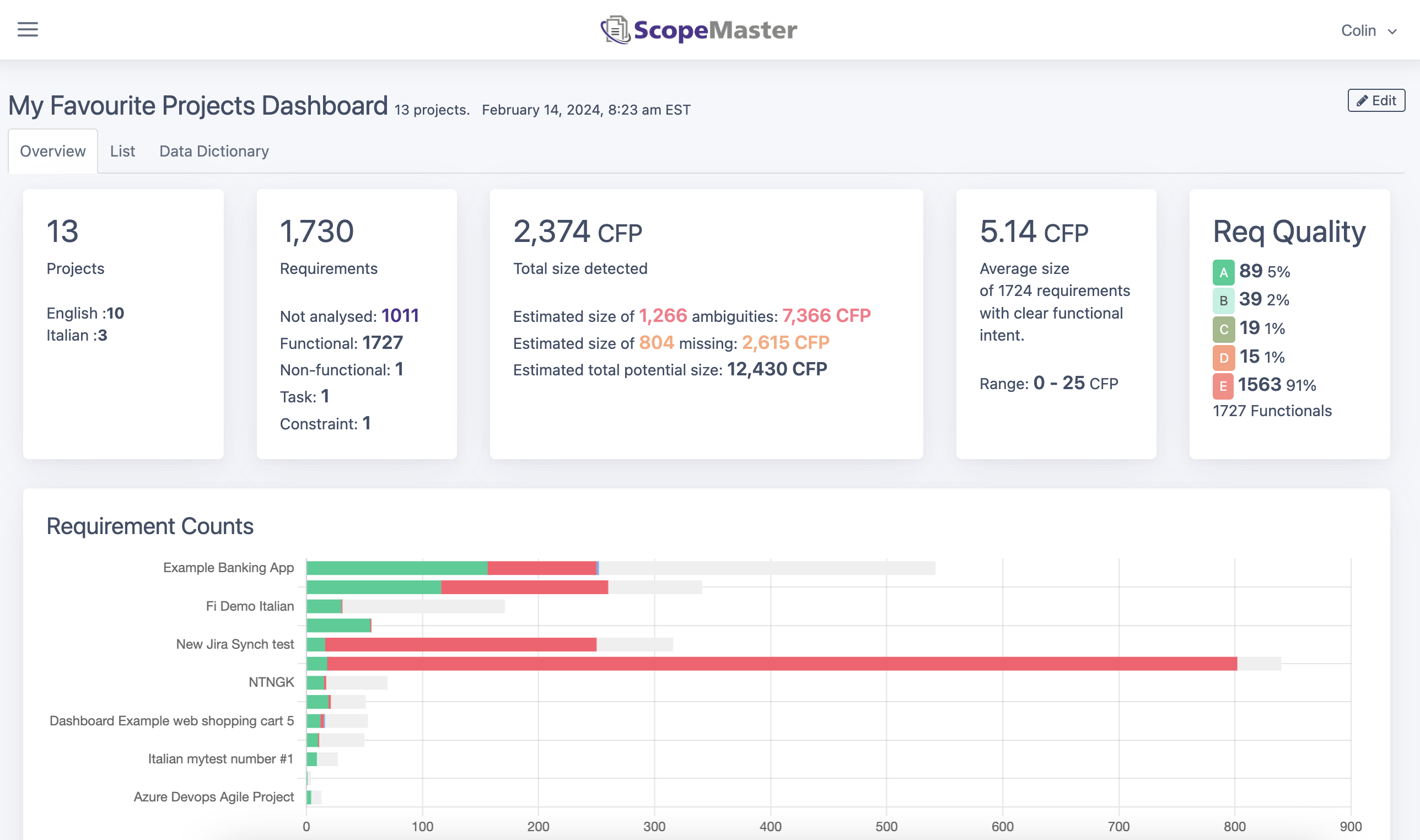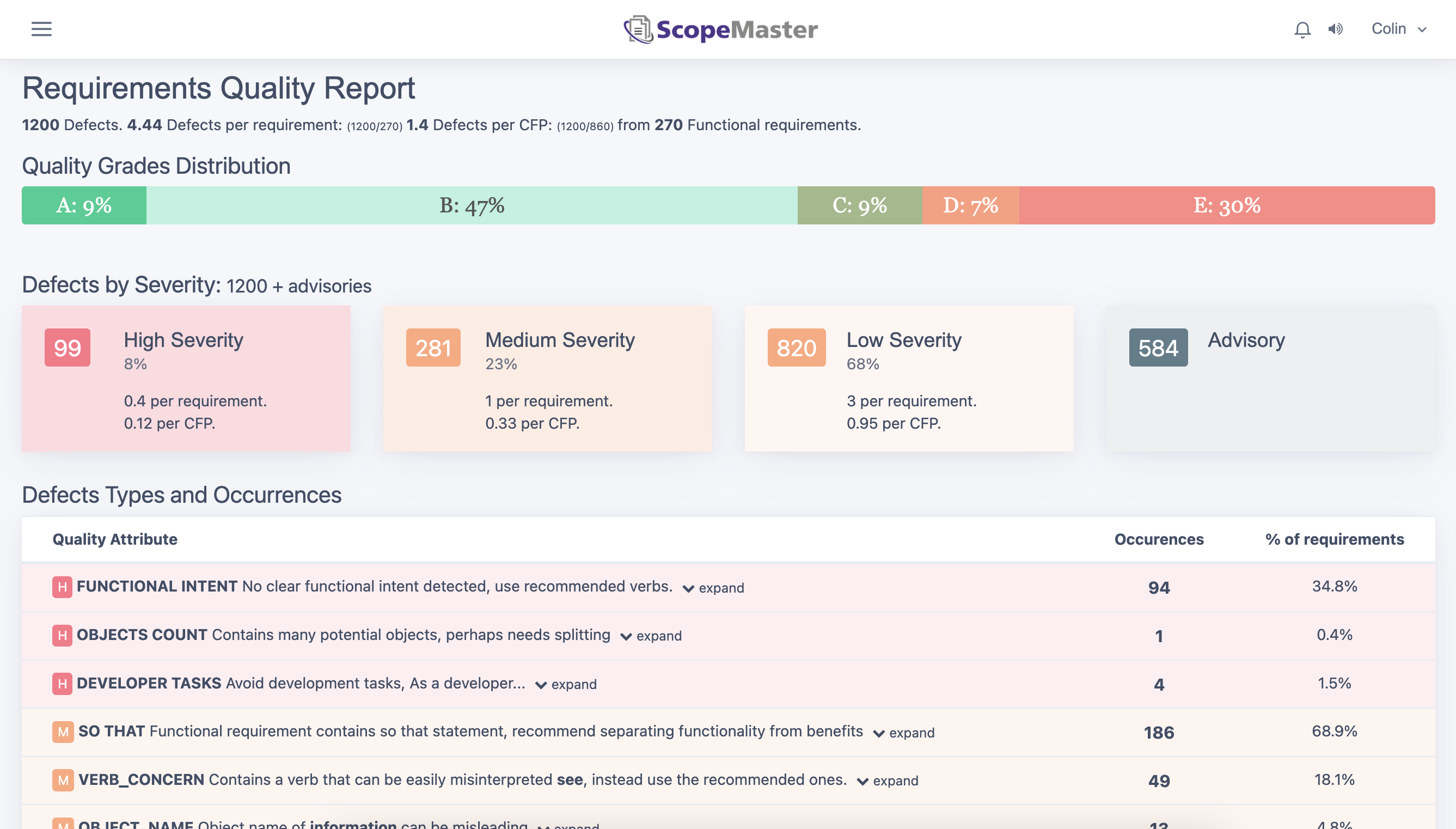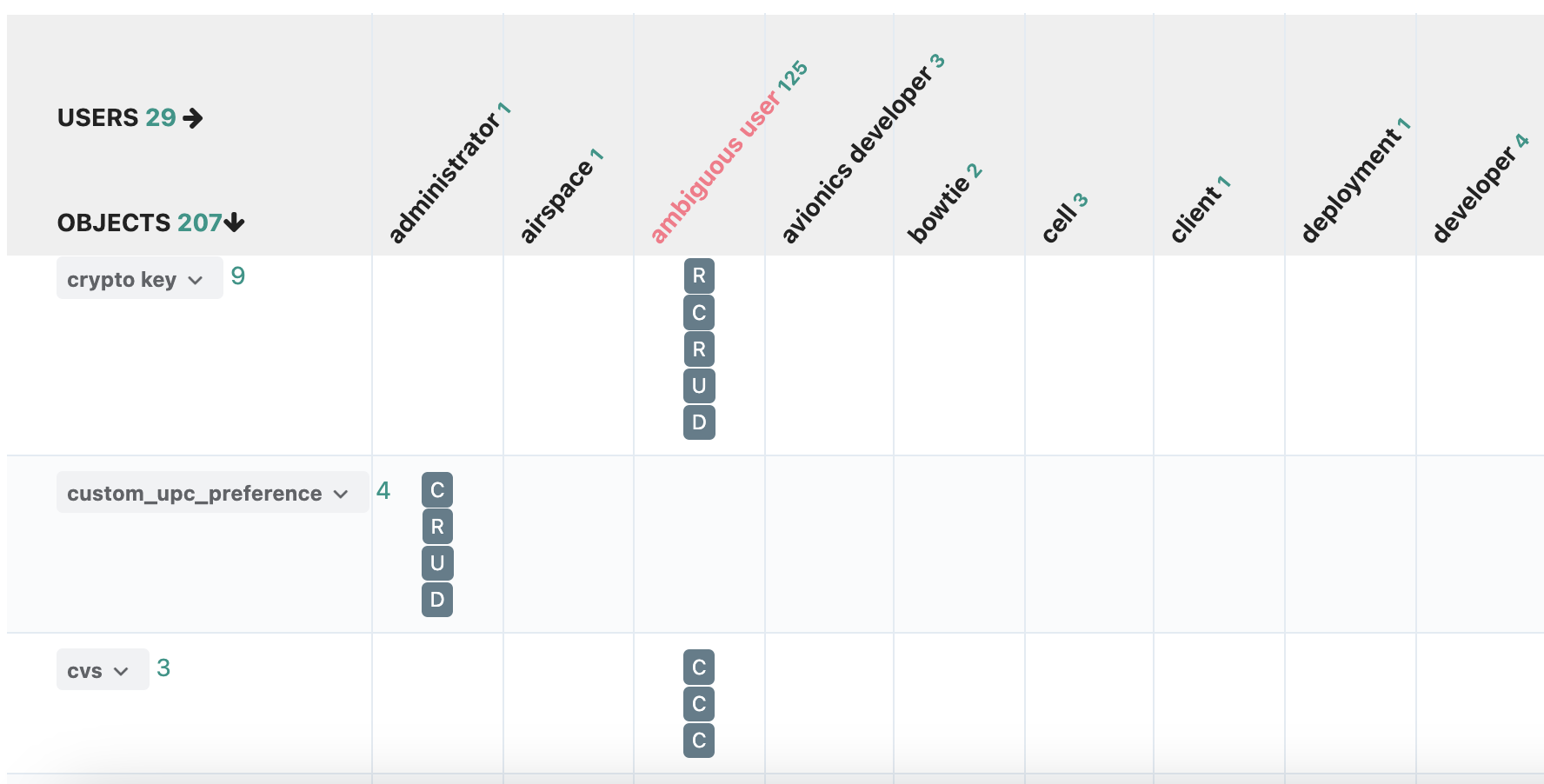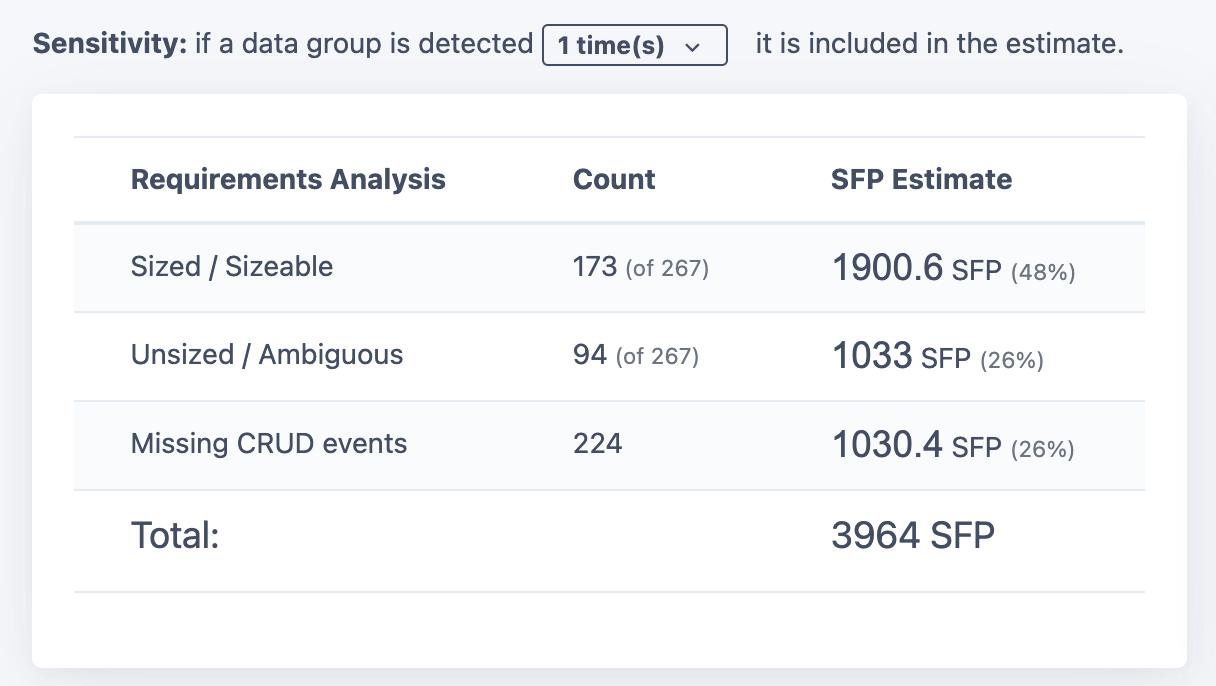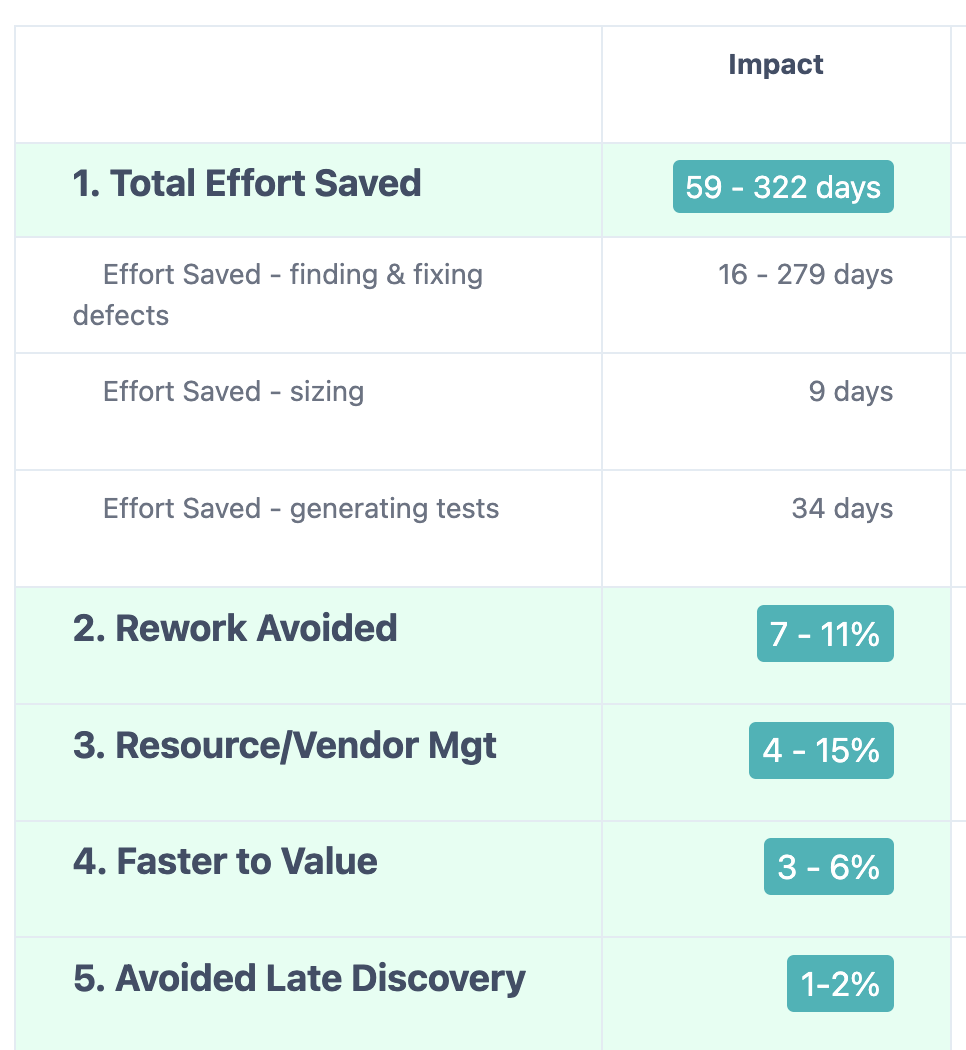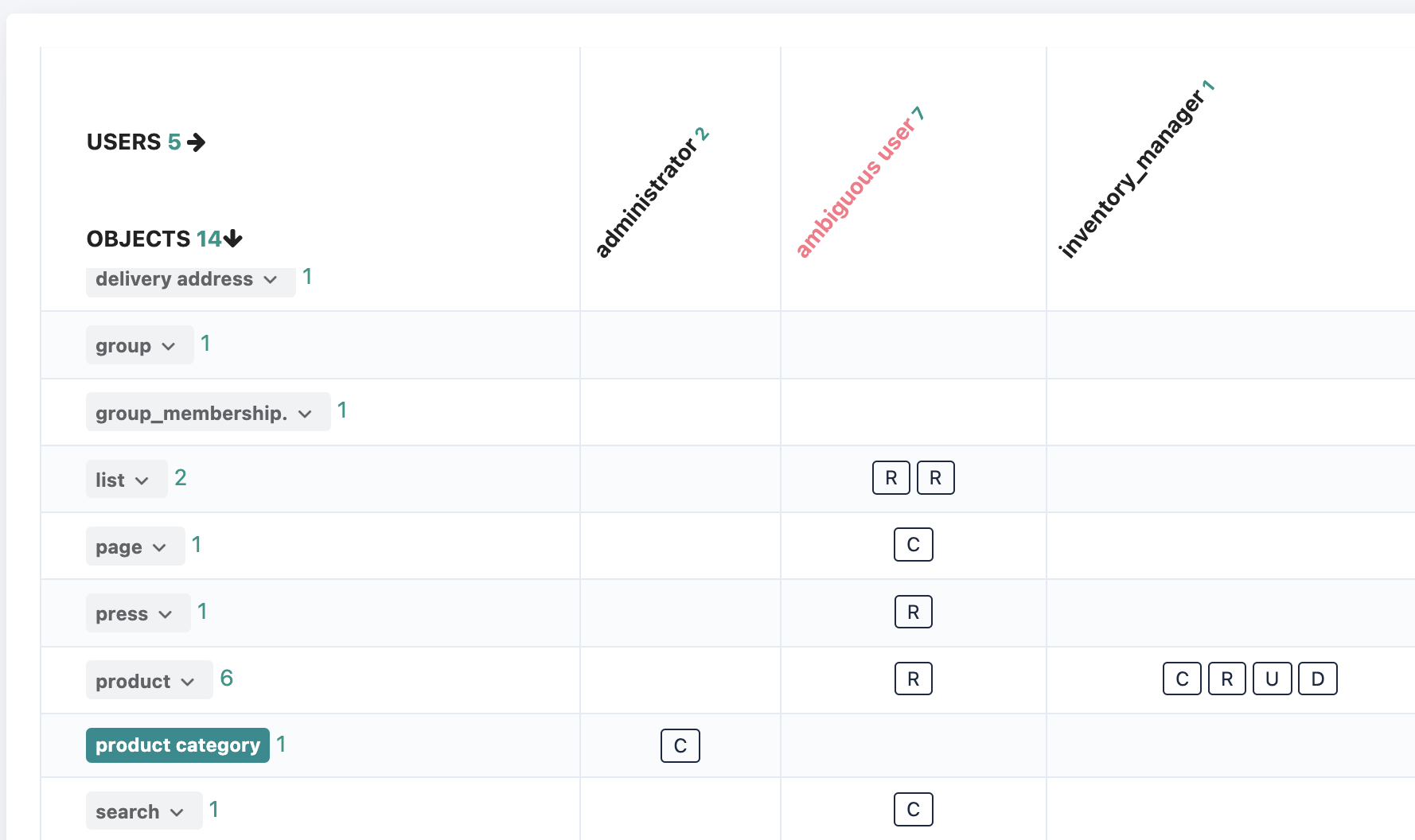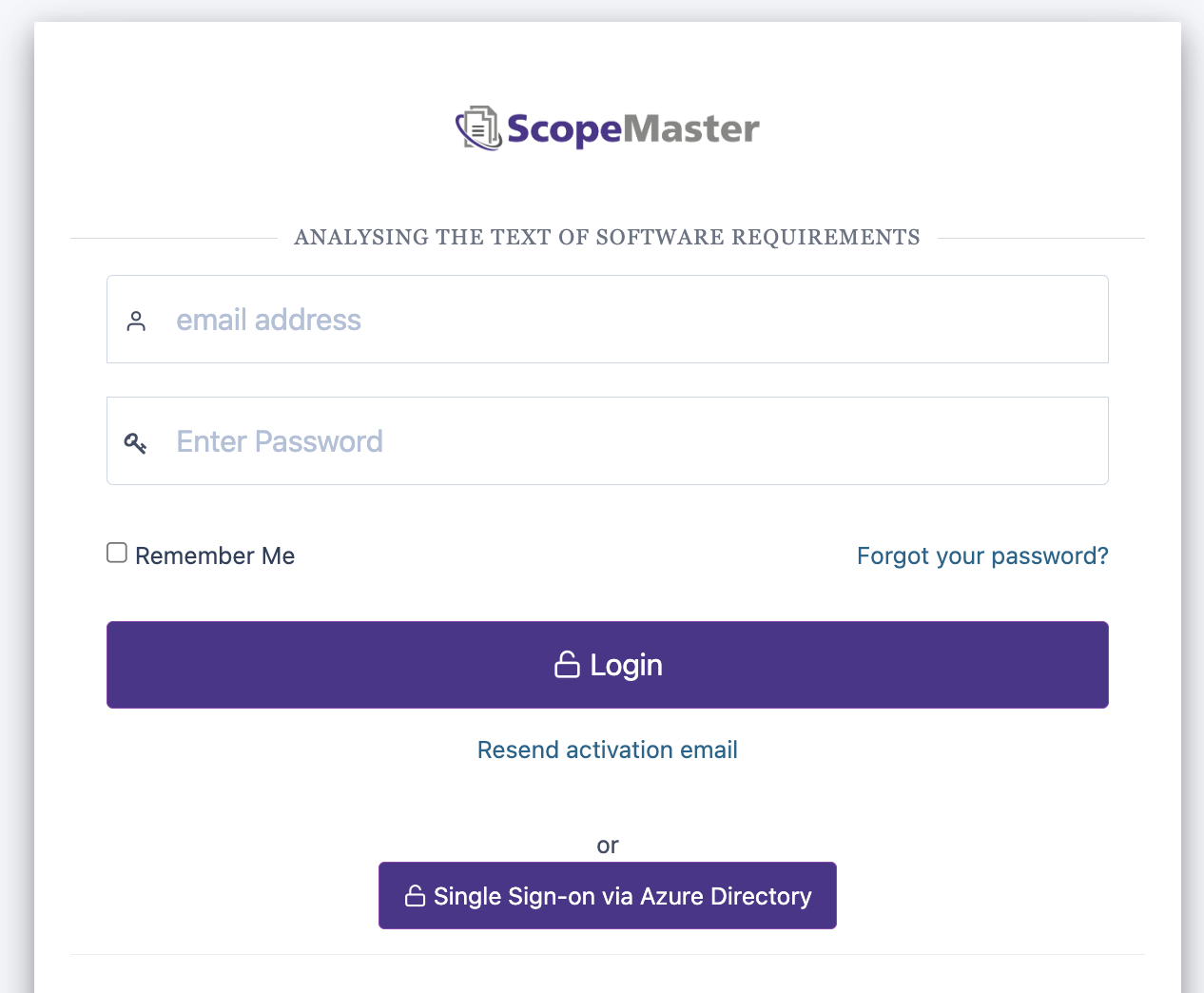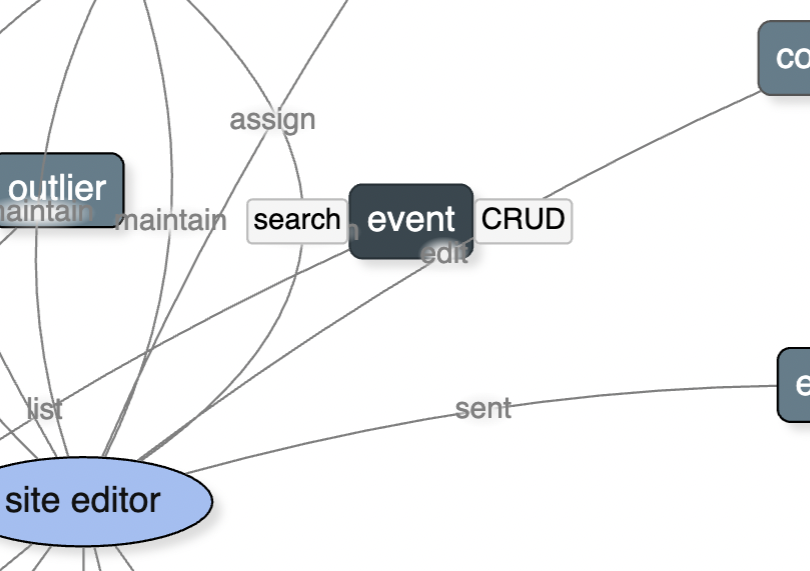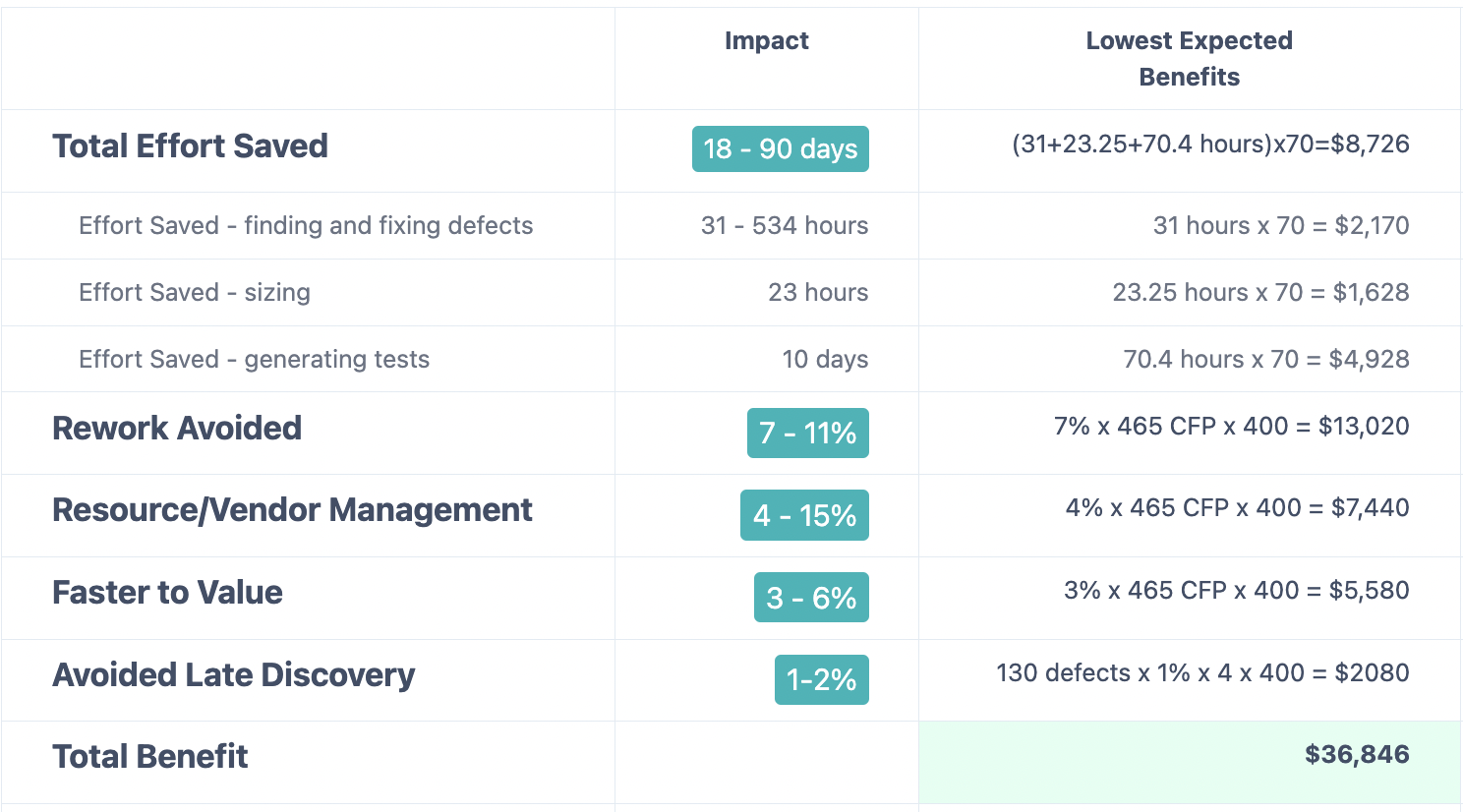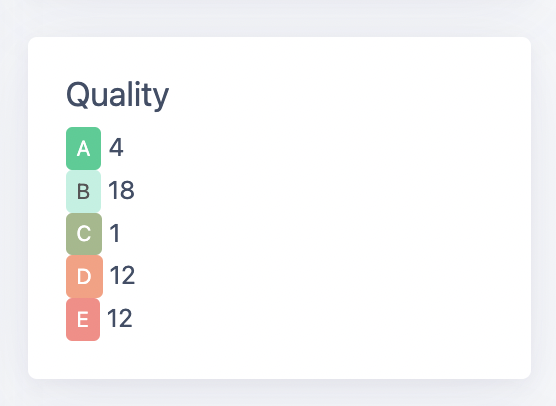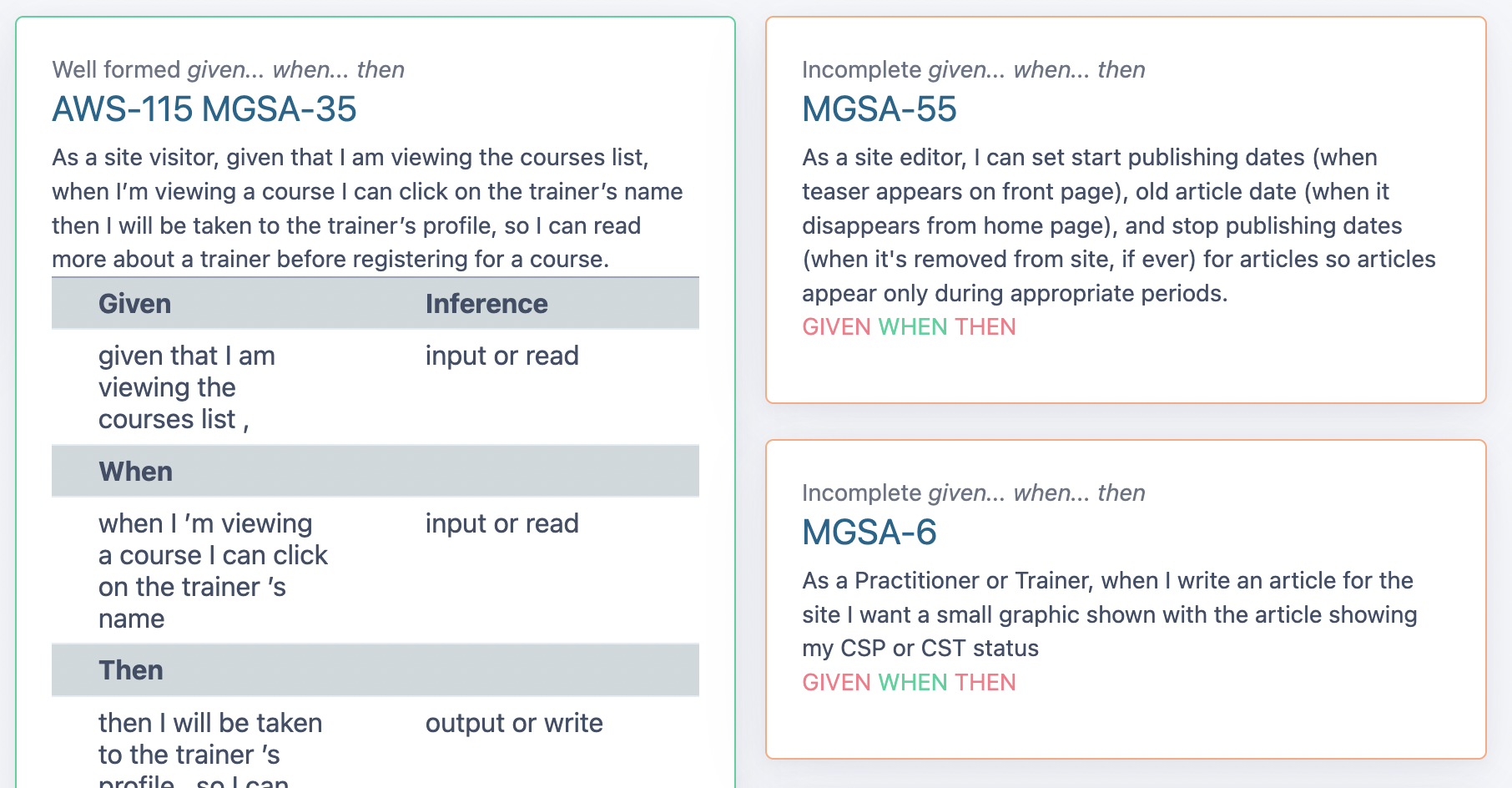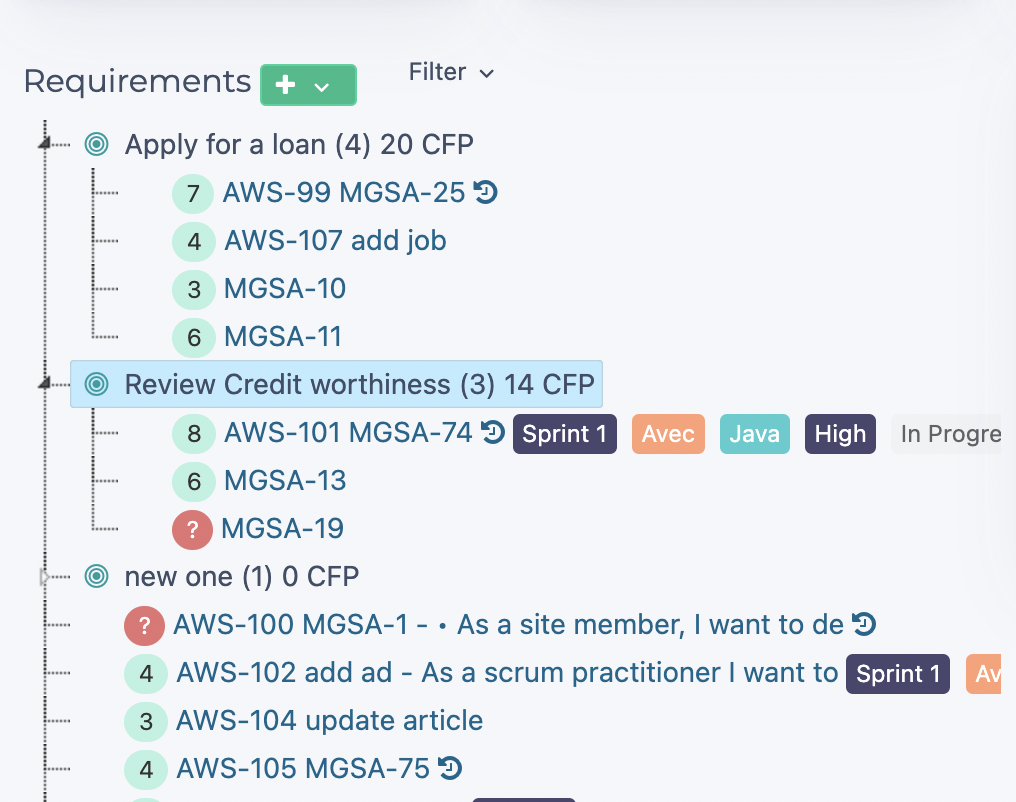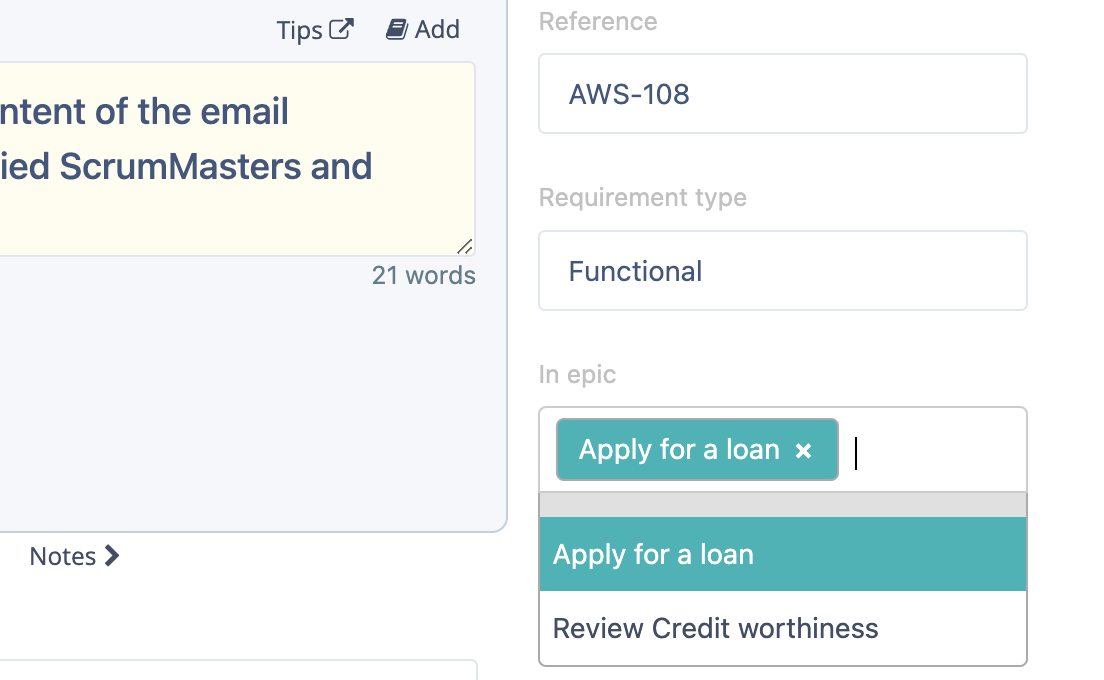ScopeMaster – Release History
Release 4.3 2024 April
- Story Analyser for Jira
- Simple Function Points – project summary auto-estimated SFP
- REST API
- New endpoint to create a project. POST app
- New endpoint to update a project. PUT app/
- New endpoint to delete a requirement DELETE requirement/requirementId
- Special characters are returned within requirement body GET app/appId/requirements
- Set requirement type with POST or PUT
Release 4.2 2024 April
- Story Analyser for Jira
- Use case model diagram – autogenerated use case model diagram of a Jira Backlog
- Analyse All – Instruct the Story Analyser to analyse an entire backlog with one button click!
- Stability and performance – over 100 improvements
- More issuetypes: Story, New Feature, Epic and Improvement
Release 4.1 2024 March
- Analyser (inc Server)
- Improved Value Tracer – interactive Product Breakdown Structure diagram that tracks size and WSJF
- API (inc Server)
- New end point – locate a single requirement by external id (e.g. Azure Devops Issue ID or Jira Issue ID)
Release 4.07 2024 March
- Analyser (inc Server)
- Improved Dashboards – improved insight
- New “over time” view – tracks requirements quality and size over time
- Improved Table views – for easy export
- Detects potential Epics – improved refinement and sizing
- Improved print layout
Release 4 2024 February
- Analyser (inc Server)
- Custom Multi-Project Dashboards – improved insight
- Improved Quality Report
- Minor improvements – 20+ improvements.
Release 3.9.5 2023 December
- Analyser
- Stability improvements
- Usability – over 100 simplifications and improvements. .
- Server
- v1 – Ready
Release 3.9 2023 October
- Analyser
- CRUD analysis by User – improved layout. Quality.
- Simple Function Point Report – adjustable sensitivity. Sizing.
- Improved Value Report – clarity. ROI.
- Minor improvements – 30+ improvements.
- Server
- Pre-launch – preparation.
- API performance and stability improvements
Release 3.8.7 and 3.8.8 2023 September
- Analyser
- CRUD analysis by User – amazing insight. Quality.
- CSV import with update – faster and better experience. Convenience.
- New tests – for inappropriate object names. Quality
- New functional verbs – reverse, undo. Quality
Release 3.8.6 2023 September
- Analyser
- Single Sign on – For organisations that are using Microsoft Azure Ad – soon to be renamed Entra. Convenience.
- CSV import with update – importing by CSV now allows you to re-import just updating those changed requirements. Convenience.
- Bulk categorisation – select search results to bulk categorise as requirement type.
Release 3.8.5 2023 August
- Analyser
- Value Report – New report that itemises the value provided by ScopeMaster. Convince your colleagues.
- Use Case Diagram – new links to jump to search and jump to CRUD table. Faster refinement.
- Acceptance Criteria – new field. Structure your user story content.
- Improved UX for new projects. Simpler experience.
- Quality grading shown in search results. Target your refinement effort. (requires re-analyze all)
Release 3.8.3 2023 July
- Analyser
- Tuning – Quality Scoring Adjusted to provide more balanced allocation of score.
- Tuning Improvement to the Audit report
- Fix Acknowledging “missing as OK” from the CRUD table now updates the quality reporting at the requirement level.
- Stand by We’ve been working hard preparing the ground for an exciting new capability that will be announced later in the summer.
- Jira Plugin
- Stability improvements.
Release 3.7 2023 April
- Analyser
- NEW Given, when and then analysis. Ideal for adopters of behaviour driven development, BDD or software with complex rules. ScopeMaster now will detect well-formed and mal-formed Given, when and then statements.
- Given, when and then analysis is also supported in Italian.
- NEW features to help you organise user stories into Epics/Capabilities.
- This facilitates top-down as well as bottom-up requirements development.
- Quickly add a user story within an epic.
- Improved selection of user stories for the flow diagram.
- NEW Given, when and then analysis. Ideal for adopters of behaviour driven development, BDD or software with complex rules. ScopeMaster now will detect well-formed and mal-formed Given, when and then statements.
- API
- NEW
org_statsendpoint available to nominated organisation administrators, lists users, apps and bundles (currently experimental).
- NEW
Release 3.6 2023 February
- Analyser
- NEW Ambiguity fix suggestions. If your requirements are flagged as “ambiguous”, ScopeMaster now suggests some potentially suitable phrases. This is particularly helpful for those who are just getting to grips with ScopeMaster and writing clear functional user stories.
- General Performance and stability with large (1000 – 5000) sets of user stories.
- CSV import performance and stability, especially with larger files.
- New experimental report – Object cross reference table, highlights the context where multiple objects are referenced.
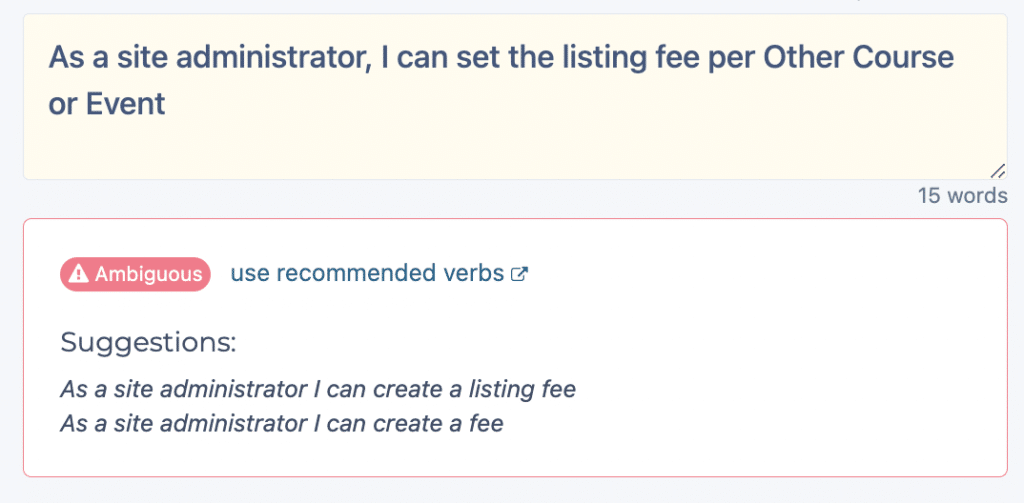
Suggested phrases to resolve ambiguities
Release 3.5.10 2023 February
- Analyser
- New report builder, allows you to generate custom reports based on different requirements selection and report features.
- Improvements to the Simple Function Point Display
- Improved print output
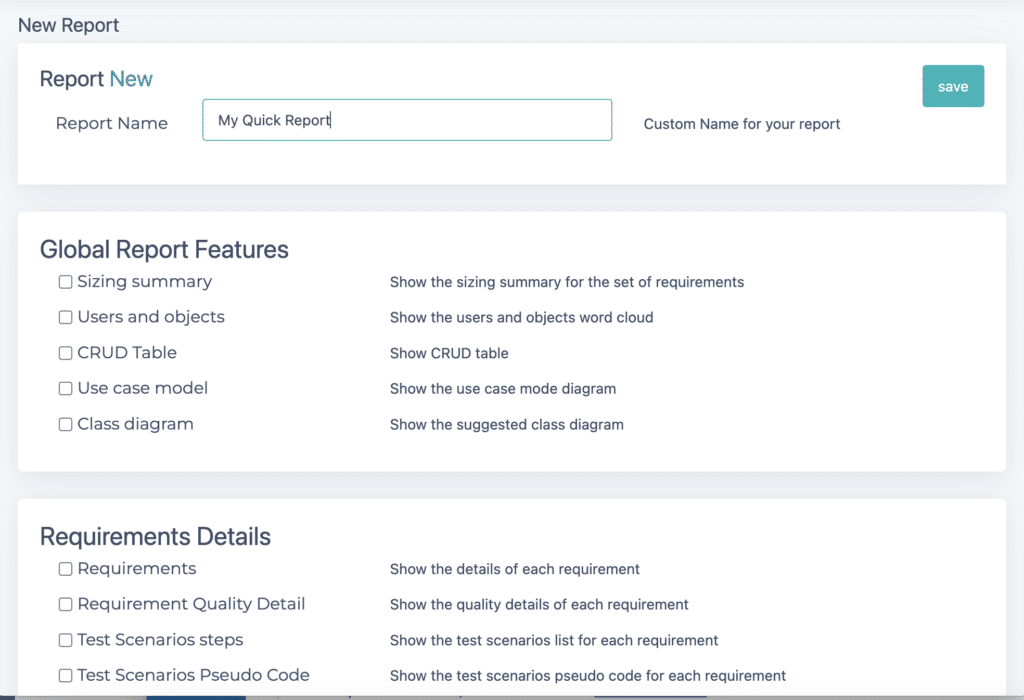
Powerful organisation of requirements with labels
Release 3.5.6 2022 December/January
- Analyser
- Major improvements to the flow designer for interactive design of user journeys.
- Improved importing of user stories by CSV.
- “Jira-like” user story references. Auto-generates unique, readable, reference IDs for improved traceability. (optional)
- Updated V 3.5.6a
- Fix to confirmed objects cannot be misunderstood as users. (thank you Michael!)
- Value Tracer UX improved for top down planning. You can now start a project defining Objectives and Capabilities, adding requirements later.
- NFR detection enriched.
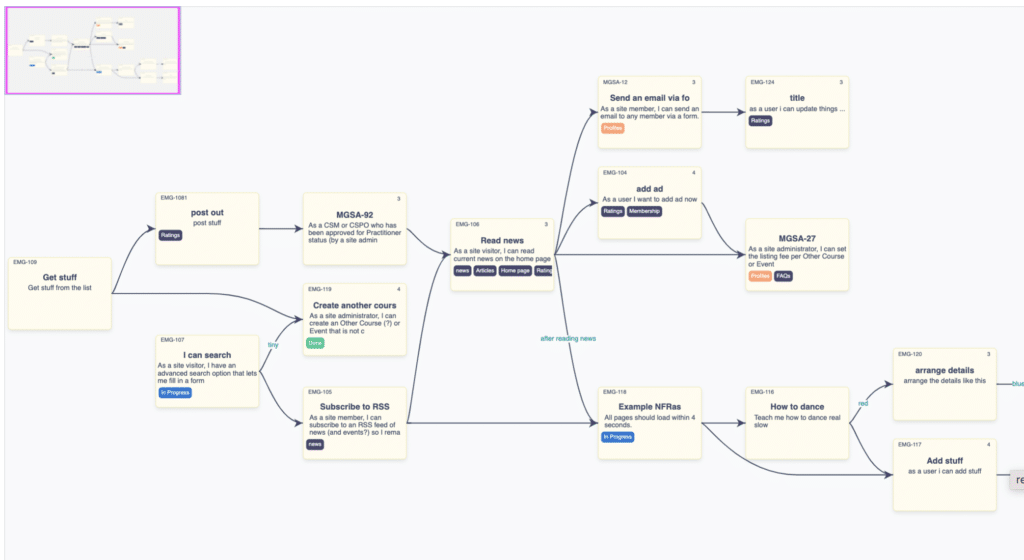
Powerful organisation of requirements with labels
Release 3.5.5 2022 December
- Analyser
- Improved importing
- Improved Kanban board, now shows labels
- New elicitation questions behind the more tab.
- Allow create a custom object in the glossary.
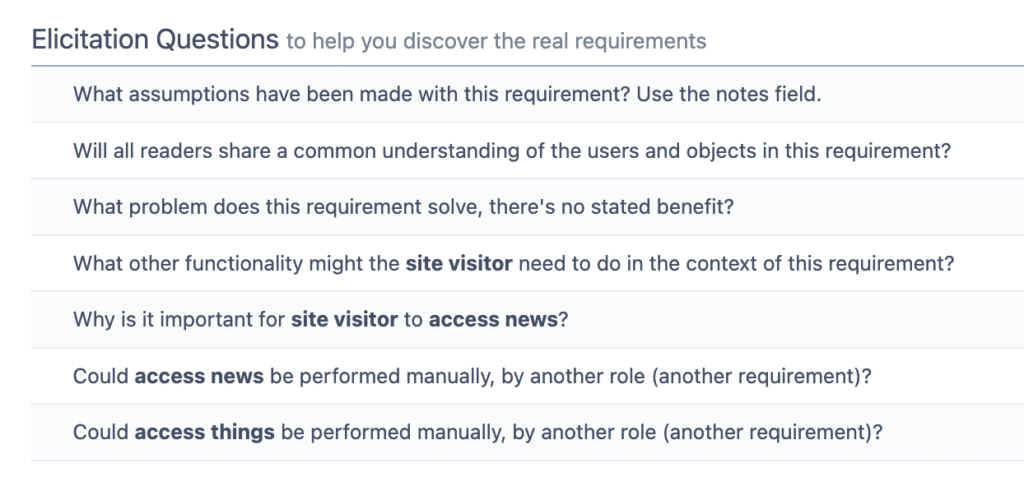
Powerful organisation of requirements with labels
Release 3.4.5 2022 November
- Analyser
- Improved report by label and filter by label
- Improved charting of functional size over time
- Improved Value Tracer UI
- More keyboard shortcuts
- Improved access to status flags (Kanban)
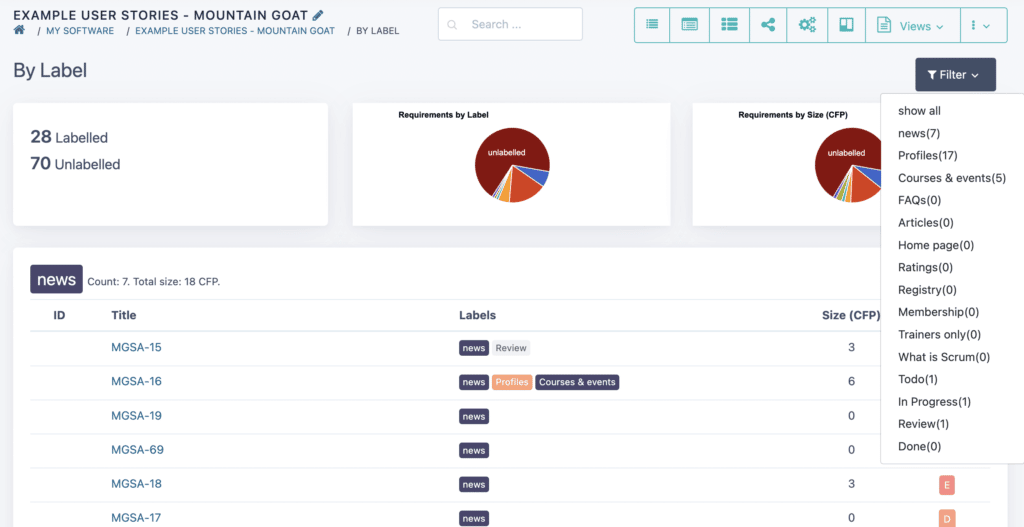
Powerful organisation of requirements with labels
Release 3.4 2022 November
- Analyser
- New gorgeous requirements quality report.
- Improved reporting of defects detected (summary report)
- Simple Function Point report – improved
- Print outputs – improved
- Single Sign-on (SSO) via Azure AD (foundations for future release).
- API
- Create a set of requirements
- Improvement to the Simple Function Points endpoint
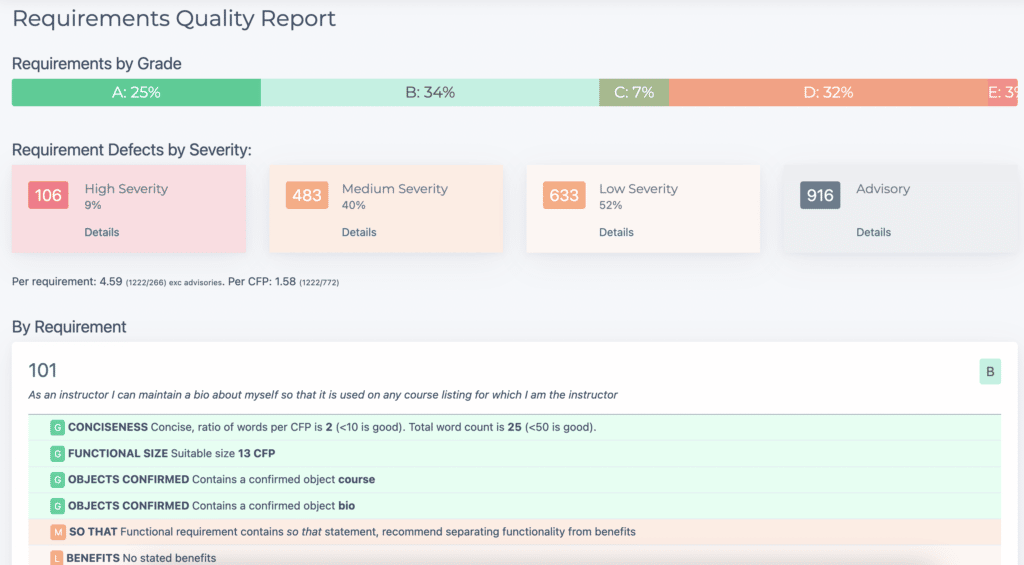
Gorgeous Requirements Quality Report
Release 3.3 21 October 2022
- Analyser – Engine Update
- Smarter functional phrase and user detection
- Intelligent handling of multiple users per requirement New
- Smarter custom glossary
- Set your custom users and objects in the data dictionary once and they will be detected throughout all the user stories in a project, no need to re-specify your custom glossary in each requirement.New
- No more ugly curly braces! They still work, but will be deprecated in a future release.
- Cleaner layout of functional interpretation.
- Foundations for shared and re-usable data glossary.
- Other minor stability improvements.
- Keyboard shortcuts to navigate between different views (instructions)
- Deprecation of the Class Responsibility Report.
- Smarter functional phrase and user detection
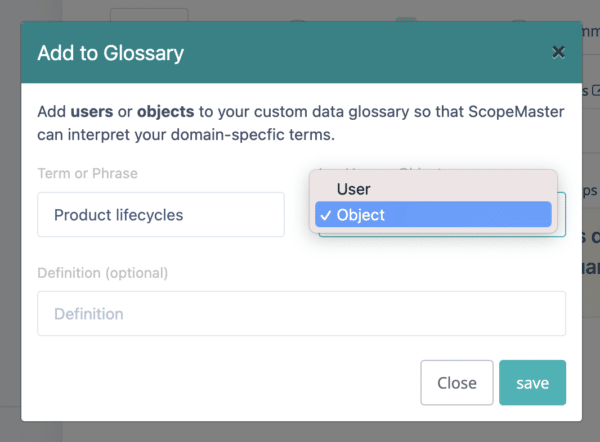
No more untidy curly braces, define your custom terms just once.
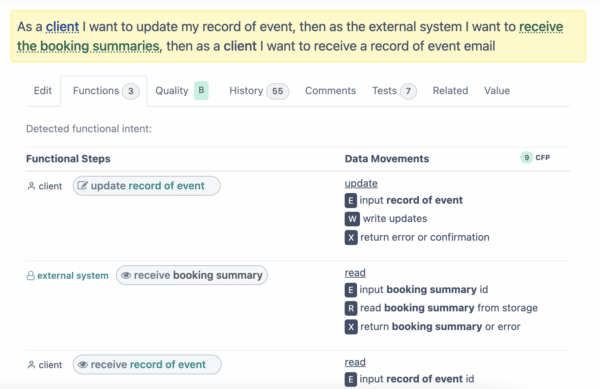
More intelligent user detection
Release 3.2.24 October 2022
- Analyser
- Apply labels to multiple requirements – with search
- Improved Layout of Use Case Model Diagram
- Import triggering event field
- Minor fix to Quality Table
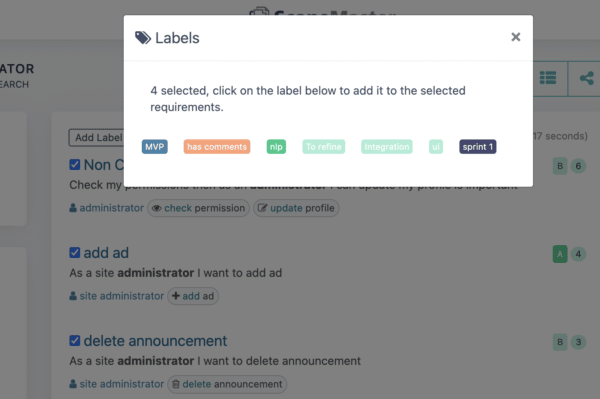
Apply labels to multiple selected requirements
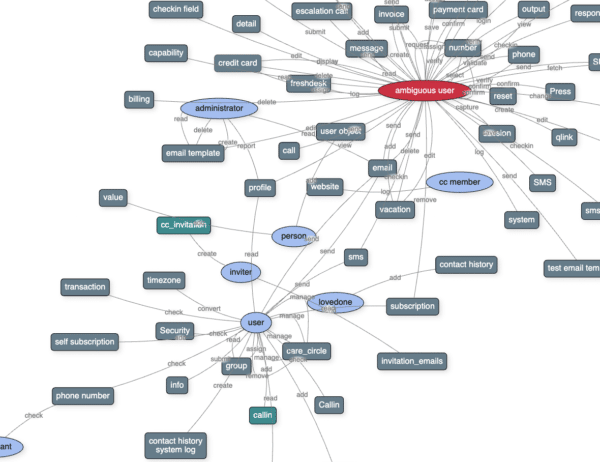
Improved Layout of Use Case Model Diagram
Release 3.2.23 September 2022
- Analyser
- Autogenerated test scripts (as pseudo code) accelerates your DevOps velocity without compromising quality.
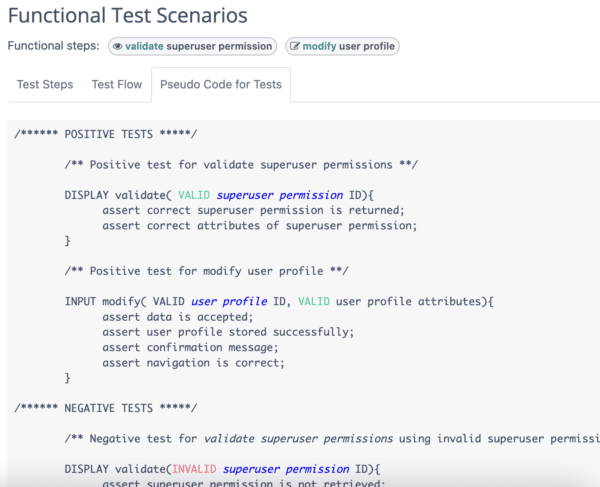
Auto generated generic test scripts
Release 3.2.22 August 2022
- Analyser
- Set custom user preferences (UI language choice and others) New
- Search improvements Improved
- Improved relevancy
- Improved partial matching
- Label searching and grouping
- Shows user and functional steps with search results (optional)
- Navigate directly from search results to CRUD context
- Visibility of object CRUD in the Users/Objects view Improved
- Audit report Improved
- Improvements to Azure DevOps integration, adds a comment in ADO with ScopeMaster results.
- Stability improvements to reduce occasional warning messages
- Over 40 accessibility improvements
- Minor UI improvements
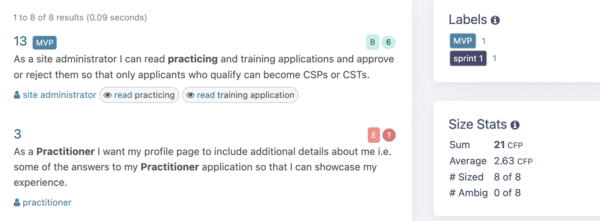
Improved search results
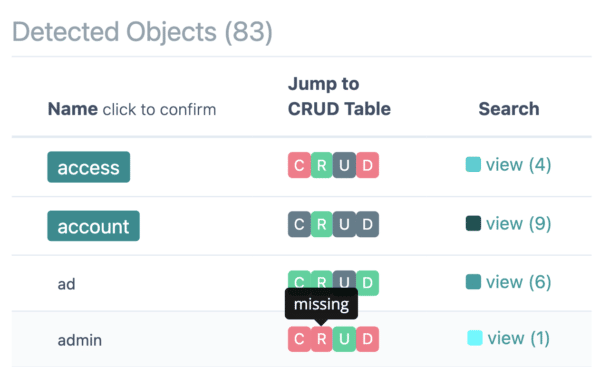
Improved CRUD visibility in the objects view
Release 3.2.20 August 2022
- Analyser
- Add attributes to confirmed objects
- Performance improvements
- Additional UI translations (Italian, French)
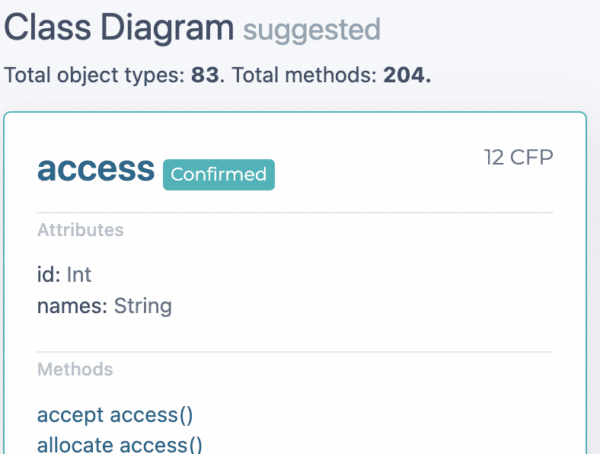
Release 3.2.19 July 2022
- Analyser
- Improved scalability and performance for very large sets of requirements 2000+
- New reporting of conciseness
- Easy navigate to CRUD context
- Improved full report display options
Release 3.2.18 July 2022
- Analyser
- Comments – improve team collaboration with the ability to add and track comments. New
- Improved UI internationalisation for French and Italian
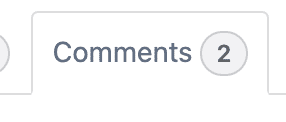
Release 3.2.15 June 2022
- Analyser
- Quality Table – see the health of your requirements at a glance.New
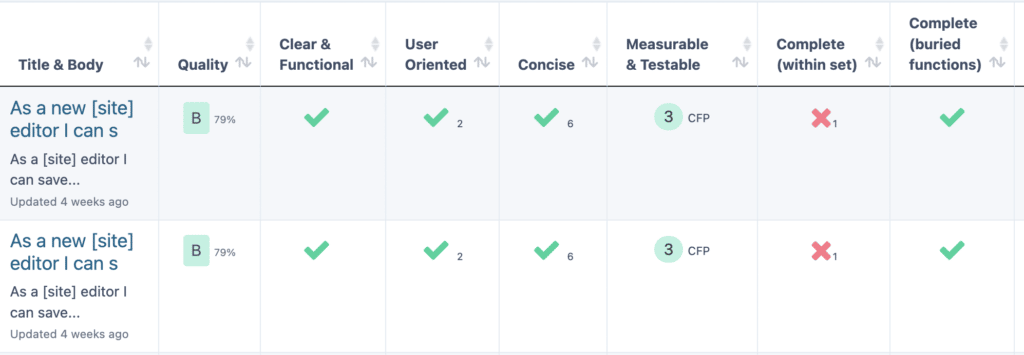
Release 3.2.14 June 2022
- Analyser
- Improved table view
- General stability improvements

Release 3.2.10 May 2022
- Analyser
- Improved Accessibility (towards WCAG 2.1 compliance)
- Adjusted quality grading (absence of Reference moved from Med to Low)
- Analyse all – now reports a running total of tests performed
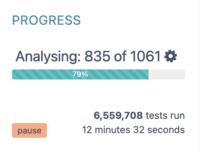
Release 3.2.9 May 2022
- Analyser
- Easy project comparison New
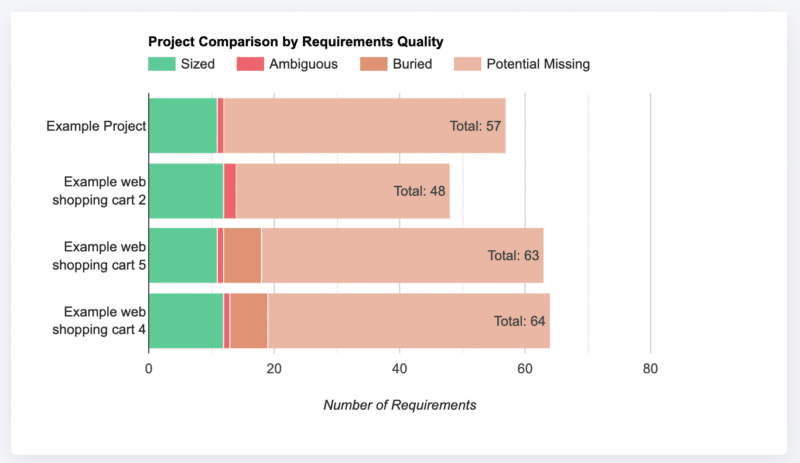
- Analyser
- Quality Grades A-E for individual requirements and sets of requirements New
- Fix – set requirement type in modal – avoids consuming a credit unnecessarily.
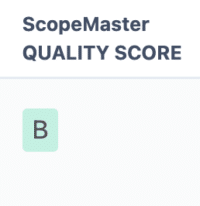
Release 3.2.8 May 2022
- Analyser
- Automated sequence diagrams New
- Filter the use case model by custom labels, allows you to visualise your requirements by an subset you choose.
- Fixed a bug that gave inconsistent messaging on saving a requirement.
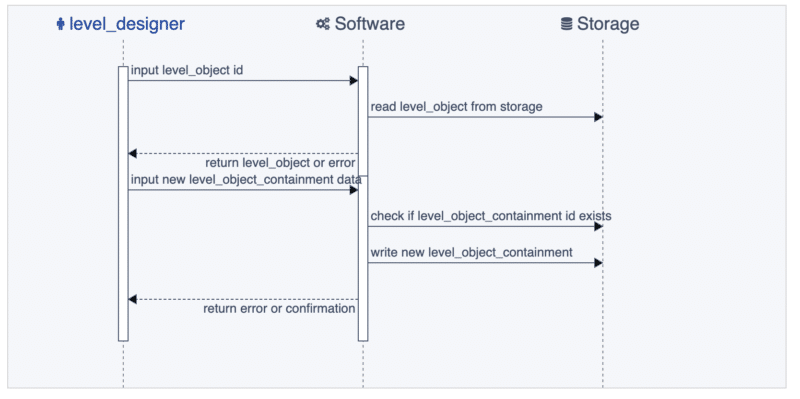
Release 3.2.6 May 2022
- Analyser
- Security improvements
- New – change requirements within the context of the Use Case Model Diagram
- Fix on changing a requirement from functional to non-functional
- Preparing for internationalisation of the UI
Release 3.2.4 March 2022
- Analyser
- Improved functional interpretation highlighting
- Improved stability with linking requirements
- Improved the table view
- Improved the Simple Function Points analysis
- Improved sign-up and forgotten password experience
- Other minor fixes
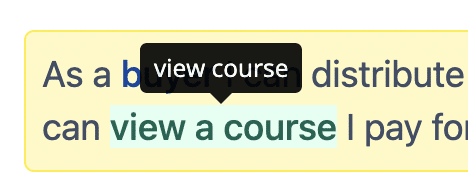
Release 3.2.3 March 2022
- Analyser
- Improved visual cues to interpretation
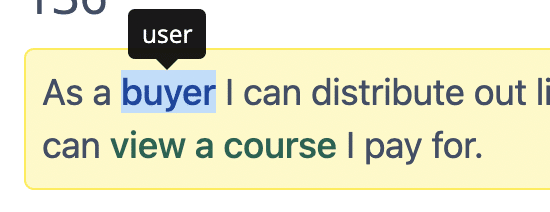

Release 3.2.2 March 2022
- Analyser
- Non Functional Requirement Detection
- New experimental feature for detecting NFRs
- Minor stability improvements
- Non Functional Requirement Detection
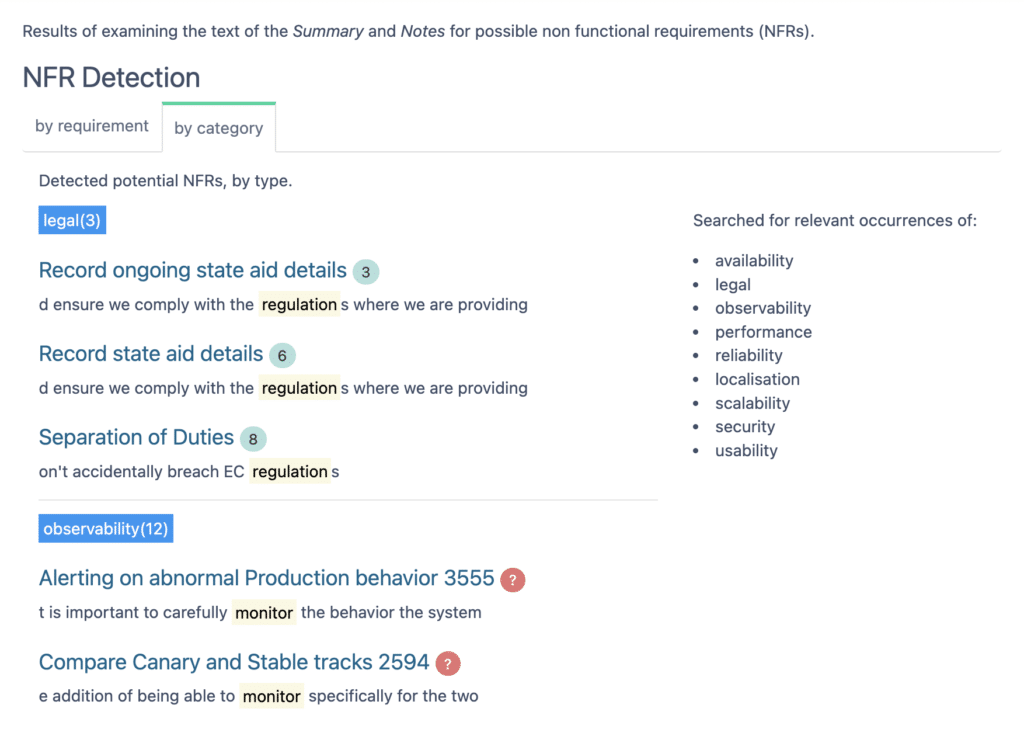
Release 3.2.1 February 2022
- Analyser
- UI improvements
- Revised colour scheme for CFP pills (to reduce visual noise)
- Minor UI improvements throughout
- New Audit History View
- UI improvements
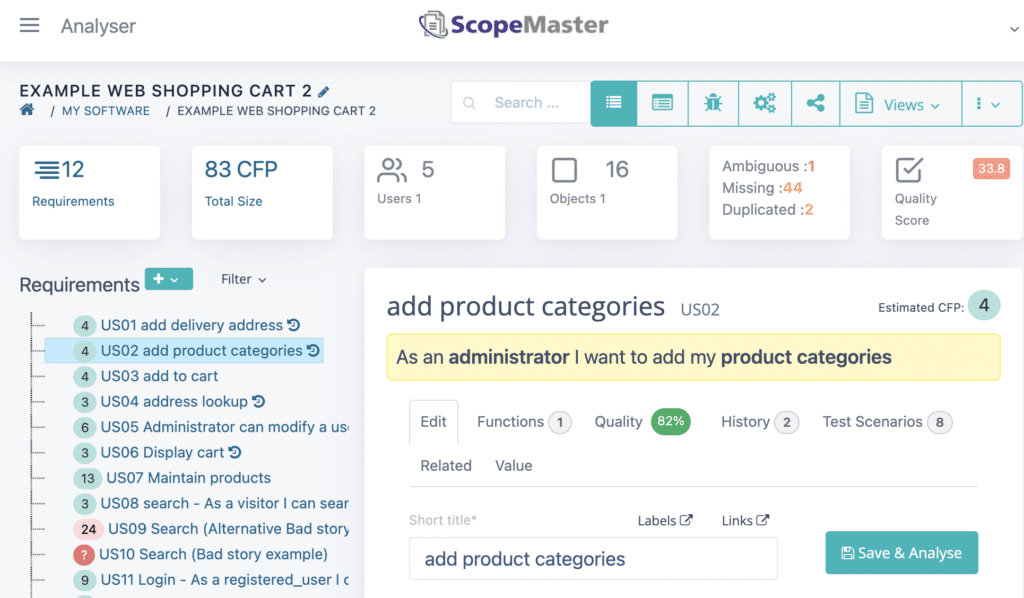
Release 3.2 January 2022
- Analyser
- Performance improvements
- Average page delivery time reduced from 0.9 seconds to 0.09 seconds. Yes, a 10x improvement!
- UI improvements
- Performance improvements
Release 3.1 January 2022
- Analyser
- NEW Configurable status flags
- NEW Kanban see details
- Displays size and quality.
- Fully featured and configurable Kanban board
- Never accept a story into a sprint until it is ready. Learn more
- General stability and UI improvements
- Jira Story Analyser
- Security and stability improvements
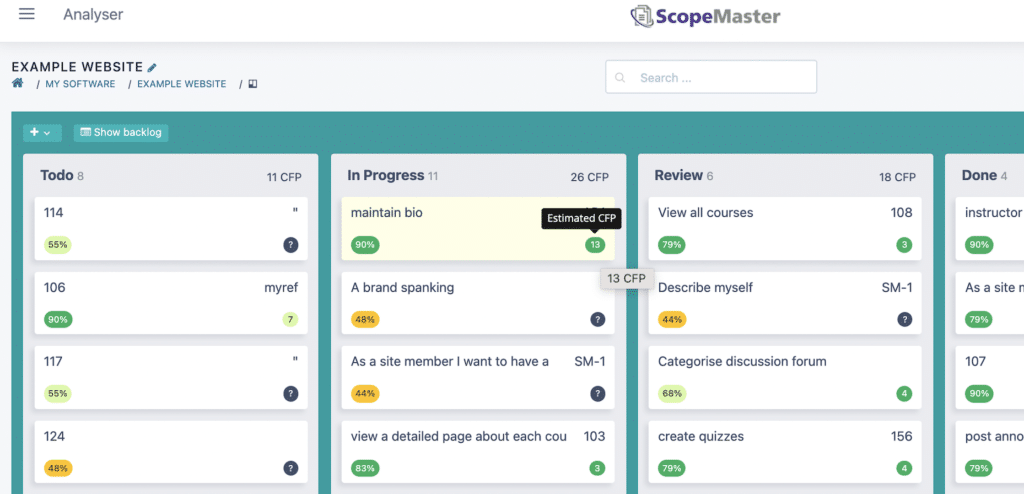
Release 3.02 December 2021
- Analyser
- 20+ improvements including:
- Class Responsibility Collaboration Card – autogenerated NEW
- Tests for potential functionality within the acceptance criteria (notes) NEW
- Improved detailed requirements sizing report
- Improved Class Diagram
- Requirements volatility chart
- Minor bug fixes.
- 20+ improvements including:
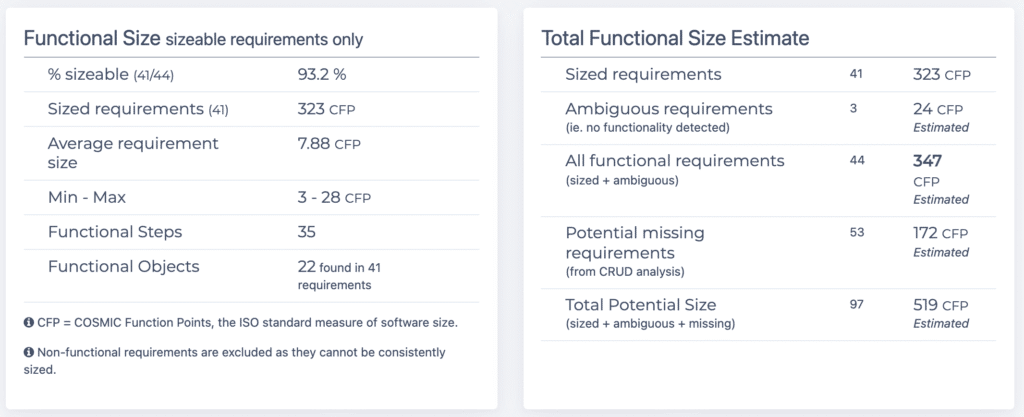
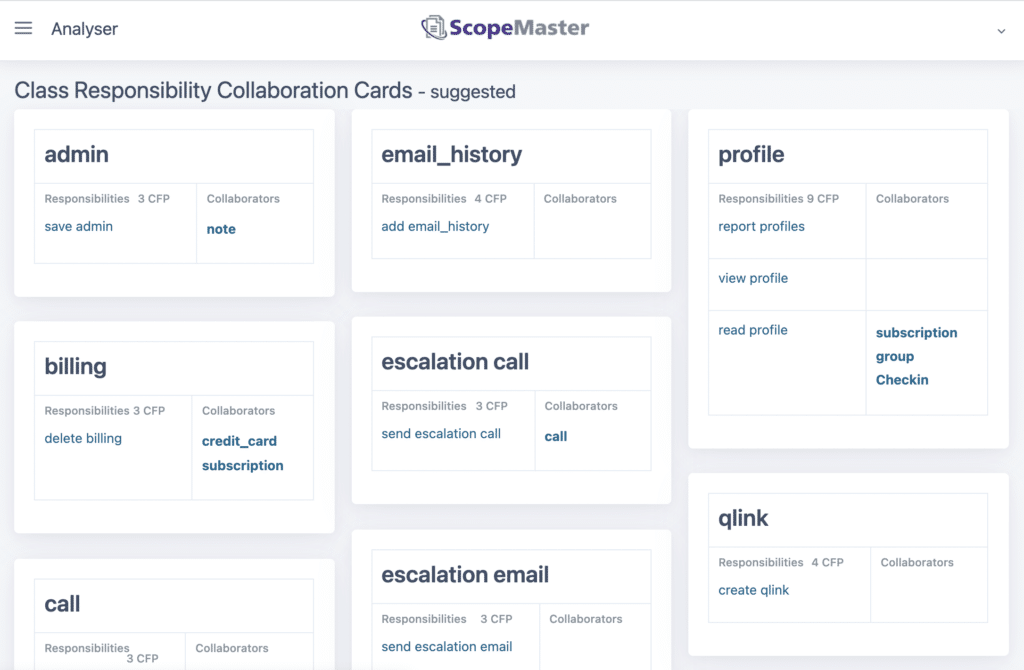
Release 3.01 December 2021
- Analyser
- Over 50 improvements including:
- CSV import flow
- Get related requirements
- Search results
- Full report view
- About project view
- Over 50 improvements including:
- Cloud infrastructure
- Improved network security and performance
- Story Analyser for Jira
- Security improvements on installation
Release 3.0 November 2021
- Analyser
- Enhanced requirement linking.
- Dynamically link your stories into insightful flows.
- Combine links with labels to create independent user flows.
- Track CFP size throughout
- Enriched data insight into a set of requirements – on the about page
- Usability Improvements to the requirement page and navigation.
- New triggering event field.
- More insight about size and objects found in search results page
- Improvements to IFPUG reporting
- Improved performance
- Deprecated sequence diagram on the requirement page.
- Enhanced requirement linking.
- REST API
- Links and labels now included when fetching analysed requirements
- Performance and stability improvements
- Story Analyser for Jira
- Security improvements
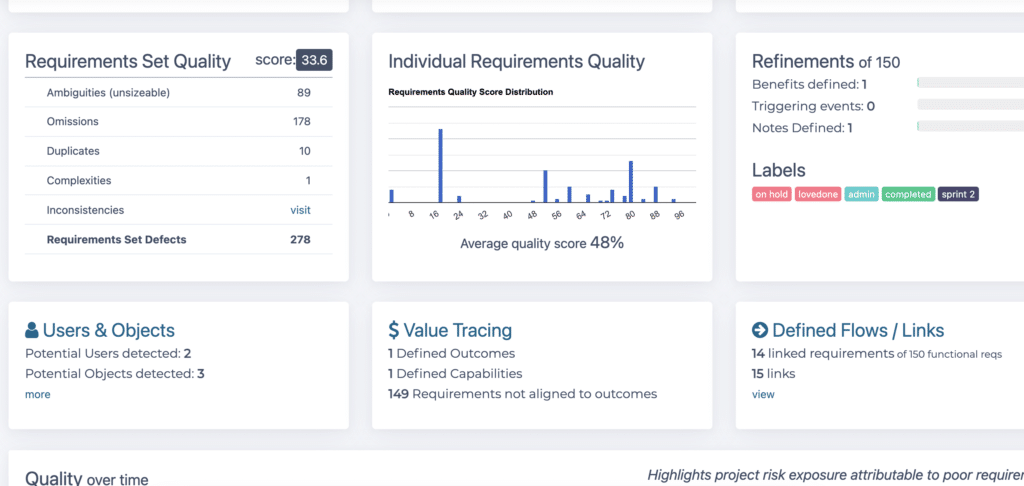
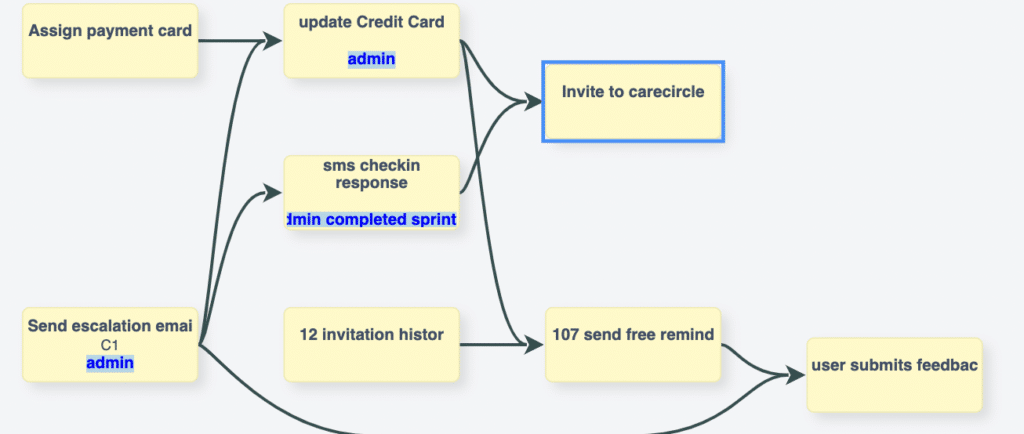
Release 2.9 October 2021
- Analyser
- Introducing requirement linking
- Preparing for future improvements
- Improved language indexing
- Jira Plugin
- Improved security
Release 2.8.5 October 2021
- Analyser
- Spellchecker enabled by default
- Some analysis settings now configurable
- Improved IFPUG and SiFP reporting
- Usability and stability improvements.
- “Last updated “added as a sortable column to table view
- User warning before consuming a credit.
- Jira Plugin
- Improved security
Release 2.8.4 August 2021
- Analyser
- Quality: Auto-detection of functionality “buried” in the acceptance criteria/notes
- SiFP: Simple Function Points Analysis added.
- Optional detection for the “as a … I want” pattern
- Usability and stability improvements.
- Jira Plugin
- Improved stability
Release 2.8.3 July 2021
- Analyser
- Improved display of test scenarios to include flow diagrams (in all views and reports).
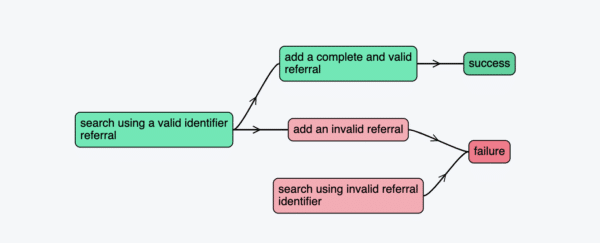
- Autogenerated test scenarios – flow
- Improved display of test scenarios to include flow diagrams (in all views and reports).
Release 2.8.1 June 2021
- Analyser
- Minor usability improvements
- Story Analyser for Jira
- Security and stability improvements
Release 2.8 May 2021
- Analyser
- Improved navigation and rendering of use case model.
- API – general fix
- Minor usability improvements
Release 2.7.1 April 2021
- Analyser
- Minor improvements
- Credit usage details
- Dutch language tuning
- Visualisation improvements
- Search results improvements
- Minor improvements
Release 2.6.9 March 2021
- Analyser
- API minor bug fixes
- UI fixes
Release 2.6.6 Feb 2021
- Analyser
- Value calculation now reports in estimated hours saved.
- Minor usability improvements
Release 2.6.5 Feb 2021
- Analyser
- Printer friendly requirement page
- Minor usability improvements
- API v1.003
- NEW Maintain endpoints for managing the glossary for an app (like a data dictionary), add, update and delete glossary items, see API documentation here
Release 2.6.2 Feb 2021
- Analyser
- NEW Dutch language support
- Duplicate a requirement
- Various minor improvements
- API: requirement PUT fix.
Release 2.6.1 January 2021
- Analyser
- Value Tracer – added estimated Cost of Delay and Weighted Shortest Job First.
- Improved story builder
- API enhanced with an option to get glossary items (see documentation here)
Release 2.6 January 2021
- Analyser
- New Value Tracer – ensure that your user stories align with real business value. Learn more about the Value Tracer. The value tracer also creates product breakdown visualisations so you can verify that your user stories are valuable.
- Improvements to organising user stories by label
Release 2.4.4 November 2020
Minor bug fixes
- Analyser
- Export now includes the quality score for each requirement
- Requirements view usability improvements
- Fix to language setting
- Story Analyser for Jira
- Minor fixes (thanks to Dr. Simon Wright)
Release 2.4 October 2020
This update brings significant improvements to the Story Analyser for Jira.
- Analyser
- Minor fixes – added scan and attach to English analyser engine.
- Story Analyser for Jira
- Introducing the CRUD Matrix – auto generated, for finding missing stories
- Improvements to the UX, performance and scalability
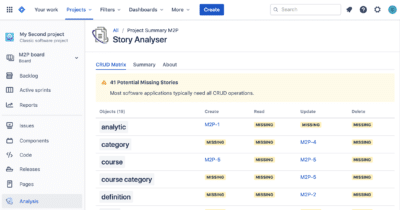
Story Analyser Now Automates CRUD Analysis, with the autogenerated CRUD Matrix to help find missing and duplicate user stories.
Release 2.3 August 2020
- Analyser
- Further scaling and performance improvements for large projects
- Story Analyser for Jira (Cloud)
- Upgraded to provide much greater value to the user
- UI bug fixes
Release 2.2 July 2020
- Analyser
- Improvements to handling larger projects of 1,000 requirements or more.
- Deprecation of the value tracer.
- Experimental – build a class diagram from user stories in just a few minutes.
- Minor bug fixes
- Saving an app sometimes reset the language setting.
Release 2.1 June 2020
- Analyser
- NEW auto generated network diagrams
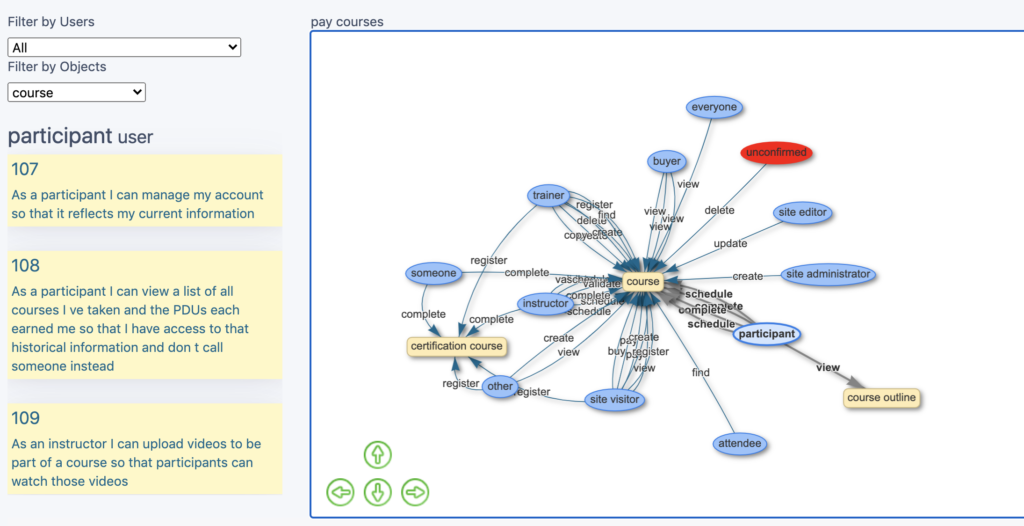
- NEW track quality and size over time
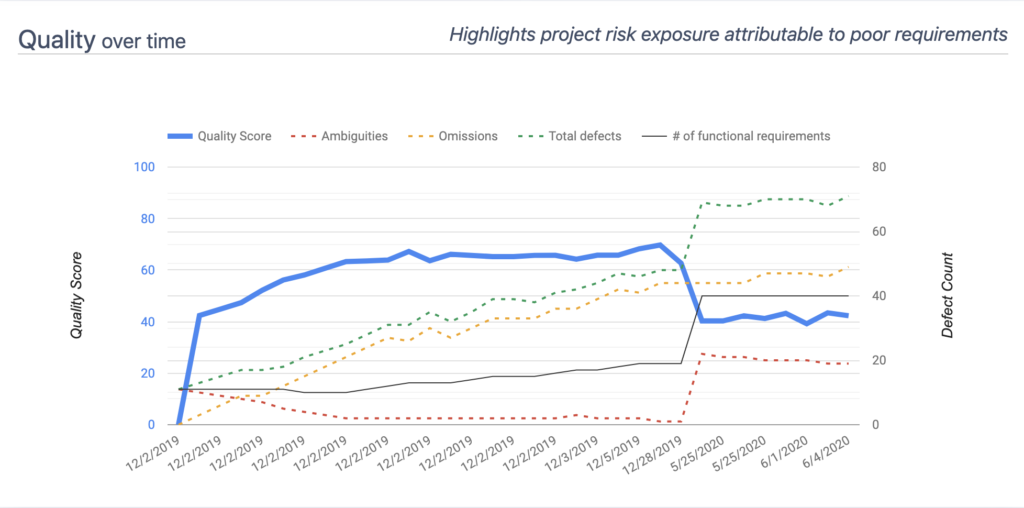
- Various minor improvements
- NEW auto generated network diagrams
Release 2.0 June 2020
- Sizer NEW
- Analyser
- Achieve clear, unambiguous user stories faster. You can now override ScopeMaster’s analyser and use curly braces to nominate specific words as
{object}and{{user}} - Portfolio-wide search improvements. Perform analysis across a portfolio of applications for impact analysis and complexity analysis.
- Scalability and performance improvements.
- Many usability improvements throughout.
- Achieve clear, unambiguous user stories faster. You can now override ScopeMaster’s analyser and use curly braces to nominate specific words as
Release 1.9.8 May 2020
- NEW Beta availability of a capability for fast and easy functional sizing in any of the following methodologies: Nesma, IFPUG, COSMIC, FFP and more.
- Improved user experience
- Scalability and performance improvements
- Search improvements
Release 1.9.7 May 2020
- Foundations for a new capability
- Improved user experience
Release 1.9.6 April 2020
- New world class hosting brings improvements across many areas:
- Auto scaling
- Secure private cloud infrastructure
- Improved resilience
- Improved performance
- Improved monitoring
- Improved user experience
Release 1.9.3 February 2020
- New Support for user stories in Italian (another world first)
- Improved printing
- Improved support for direct synchronisation with Azure Devops
Release 1.9.2 January 2020
- 100 more automated requirements tests
- Quality Score for every requirement now available in the REST API
- Stability and presentation improvements
Release 1.9 December 30th 2019
- NEW requirements quality framework and over 200 new automated tests for a range of specific problems.
- NEW automated tests of requirements for some potential security flaws.
- NEW benefits field, so that every requirement has a business justification.
- Improved performance and security
- Improved usability and print display
- Added a limit to the text length of the functional user story
- Improvements to Spanish interpretation accuracy
- Modification to synchronisation support changes to the Jira API
Release 1.8.2 November 26th 2019
- NEW REST API, so you can:
- Synchronise user stories with any other tool.
- Embed user story QA as part of any CI/CD routine.
- Extract auto generated test scenarios.
- Use your existing tools to include portfolio and project reporting of functional size and user story QA.
- Check out the API documentation
- Improved Usability (several small improvements)
- Improved documentation at help.scopemaster.com
Release 1.8.1 November 3rd 2019
- NEW Synchronise stories with Azure DevOps (cloud)
- Improved Usability (many improvements)
- Improved security and stability
Release 1.8 October 27th 2019
- NEW Synchronise stories with Jira (cloud) and PivotalTracker
- NEW Experimental support for User Stories written in Portuguese and Spanish
- Improved stability and usability
Release 1.7.4 September 1st 2019
- Revised algorithm allows multiple operations on the same object within a single user story
- Reference / id is used to sequence stories on the main board.
- Additional guidance on improving user stories
- Improved analyser performance
- Improved exporting (Stories, Glossary and Tests)
Release 1.7.3 August 10th 2019
- Improved search functionality – results all sized in CFP
- Improved guidance on home screen
Release 1.7.2 July 29th 2019
- NEW – Functional Tests Cases (downloadable)
- NEW – Glossary of definitions
- NEW – Gamificaiton – It’s fun to create great user stories and achieve 100% quality.
- Allow for Non-functional requirements, Tasks and Constraints
- Navigation improvements to make it faster and easier to improve your user stories.
- Other performance, stability and security improvements
Release 1.6.3 9th July 2019
- UX improvements
- Value Traceability – beta
Release 1.6 , 30th June 2019
- Clearer analysis presentation
- New sequence diagrams
- Option to confirm and specify users and objects.
- New, simpler, bundle-based billing
Release 1.5.2 22 June 2019
- Slice and dice your user stories like never before (by user, by object, by label). New presentation that will help you improve your user stories faster than ever.
Release 1.5.1 15 June 2019
- Upload a CSV file and map your fields dynamically – importing goes from minutes to seconds.
- Related stories – ideal for regression test targeting, a powerful cross correlation of user stories that touch the same object or user; .
- Export now includes CFP values
- Overhaul of the Labelling UX, it’s now easier than ever to label and organise your requirements, for more efficient working.
- Dozens of usability improvements – because it should be intuitive and easy to do good requirements work.
Release 1.4.5 24 May 2019
- User story title is no longer analysed for data movement intent
- Other usability, cosmetic and stability improvements
Pre-Production release 0.88, 25 March 2018
- Improved full screen display and responsive menus
- Improved defects report
- Easy navigation back to recently visited user stories
Pre-Production release 0.87, 17 March 2018
- NEW Sortable, searchable table, ideal for story grooming
- Improved text analysis accuracy
- Simplified defects report
- Improved performance for very large projects
Pre-Production release 0.85, 6 March 2018
- NEW Users can share work with others in their organization.
- NEW Share work at the application level: owners can assign read or edit access to others in their organisation.
- NEW Requirement text within square brackets will be ignored from sizing analysis.
- NEW Requirement export/download as csv.
- Improved IFPUG Function Point estimates, with function-by-function details report.
- Improved text analysis accuracy.
- Improved UI and bug fixes.
- Improved searching
- Improved application performance.
- Improvements to application data security.
- Major improvements to server(s) security.
Beta, 14 December 2017
- Automatically
- analyses the text to describe software requirements
- Interprets user story terminology and common active phrases
- identifies candidate users and objects from the entire body of requirements text
- detects potentially defective requirements – ambiguous
- detects potentially defective requirements – omissions
- detects potentially defective requirements – duplicates
- Identifies functional data movements
- Identifies data to be maintained
- estimates the functional size of the software – in Cosmic Function Points
- provides estimates for: cost to develop, defect potentials, resource requirements and likely schedules.
- Accuracy of functional sizing is currently around 70-80% (N.B. manual accuracy can vary by up to 10%)
- Import by text list or csv
- Ability to take a snapshot track the size progression.
- Portfolio view
- Import 2 column spreadsheet
- Basic text analysis engine
- Initial CFP structure

